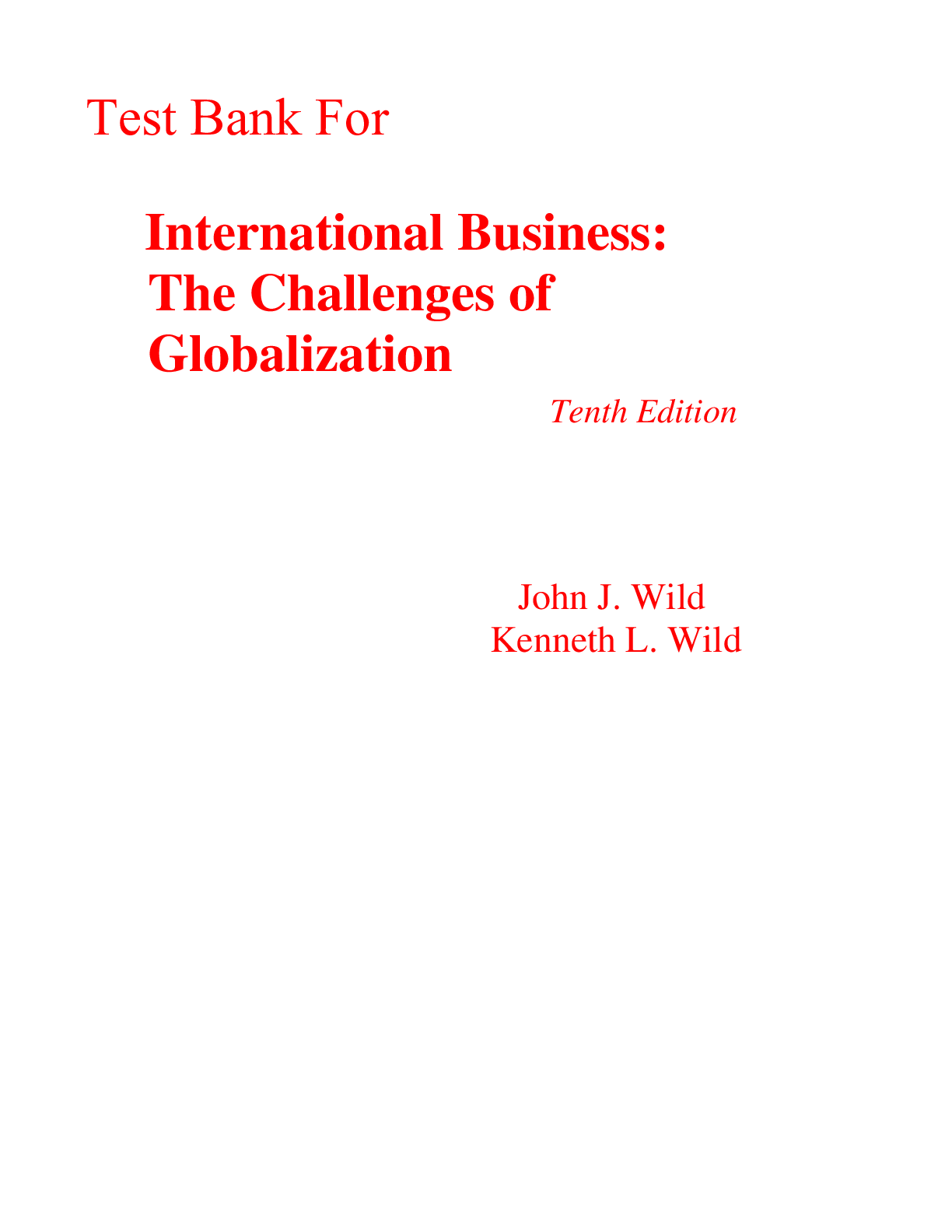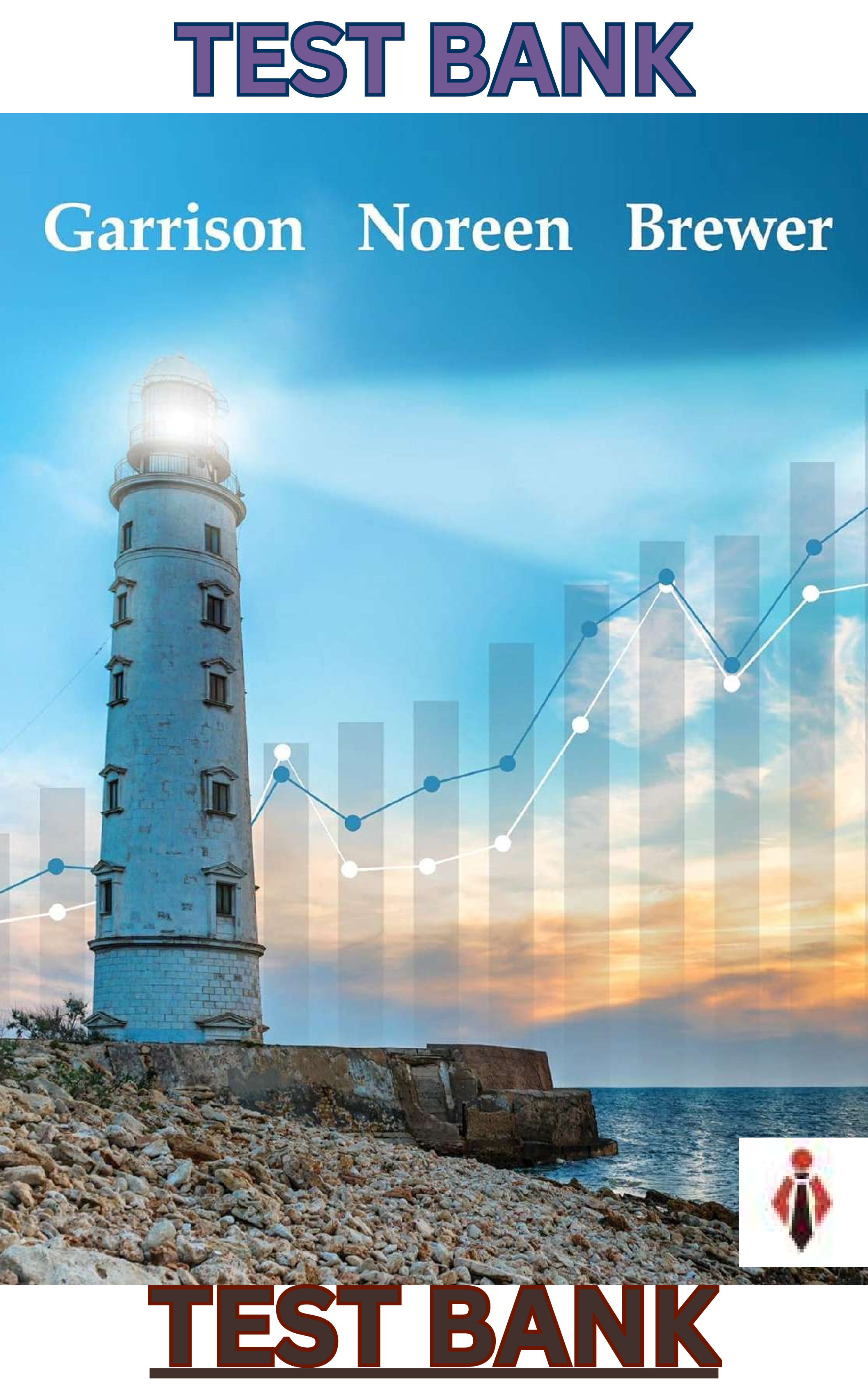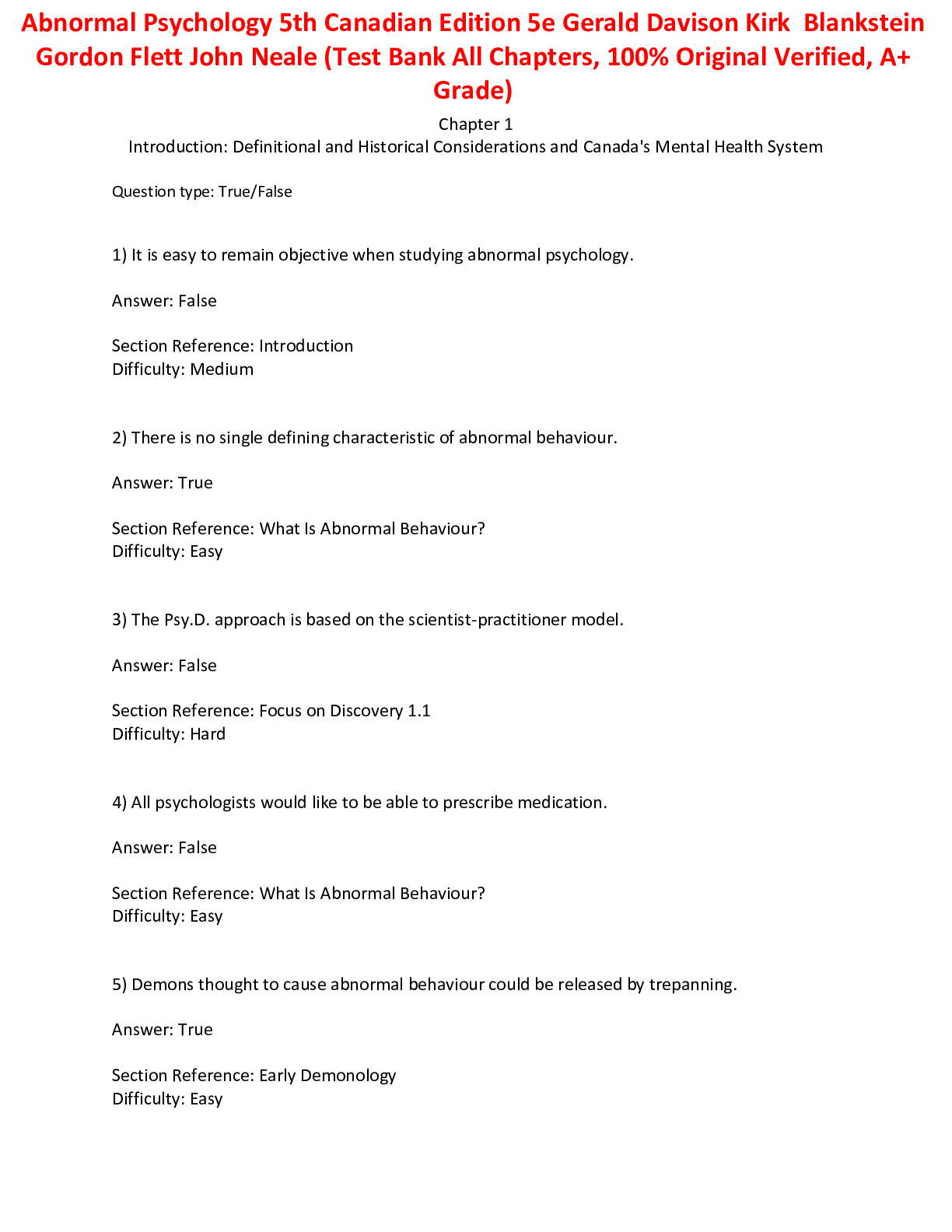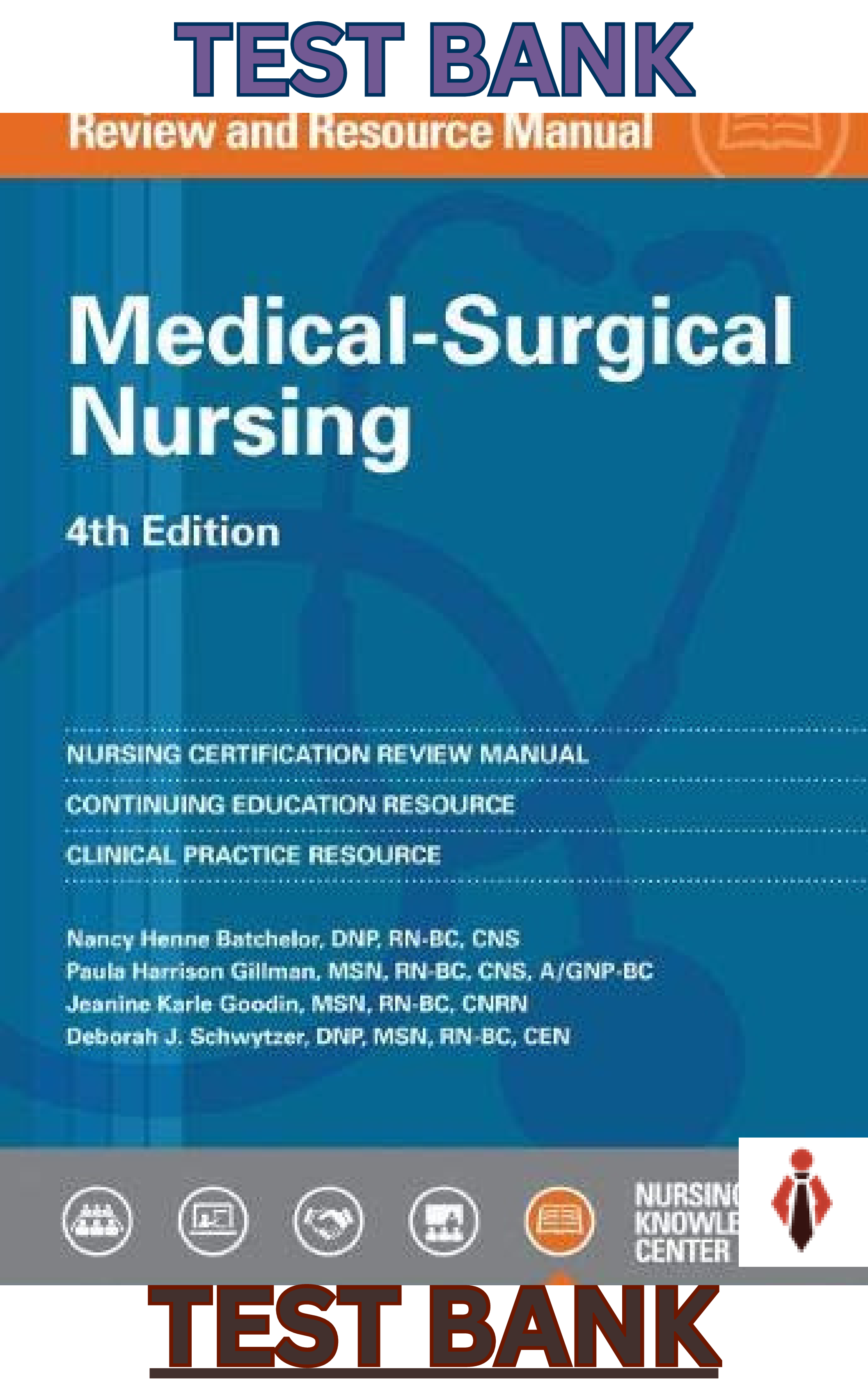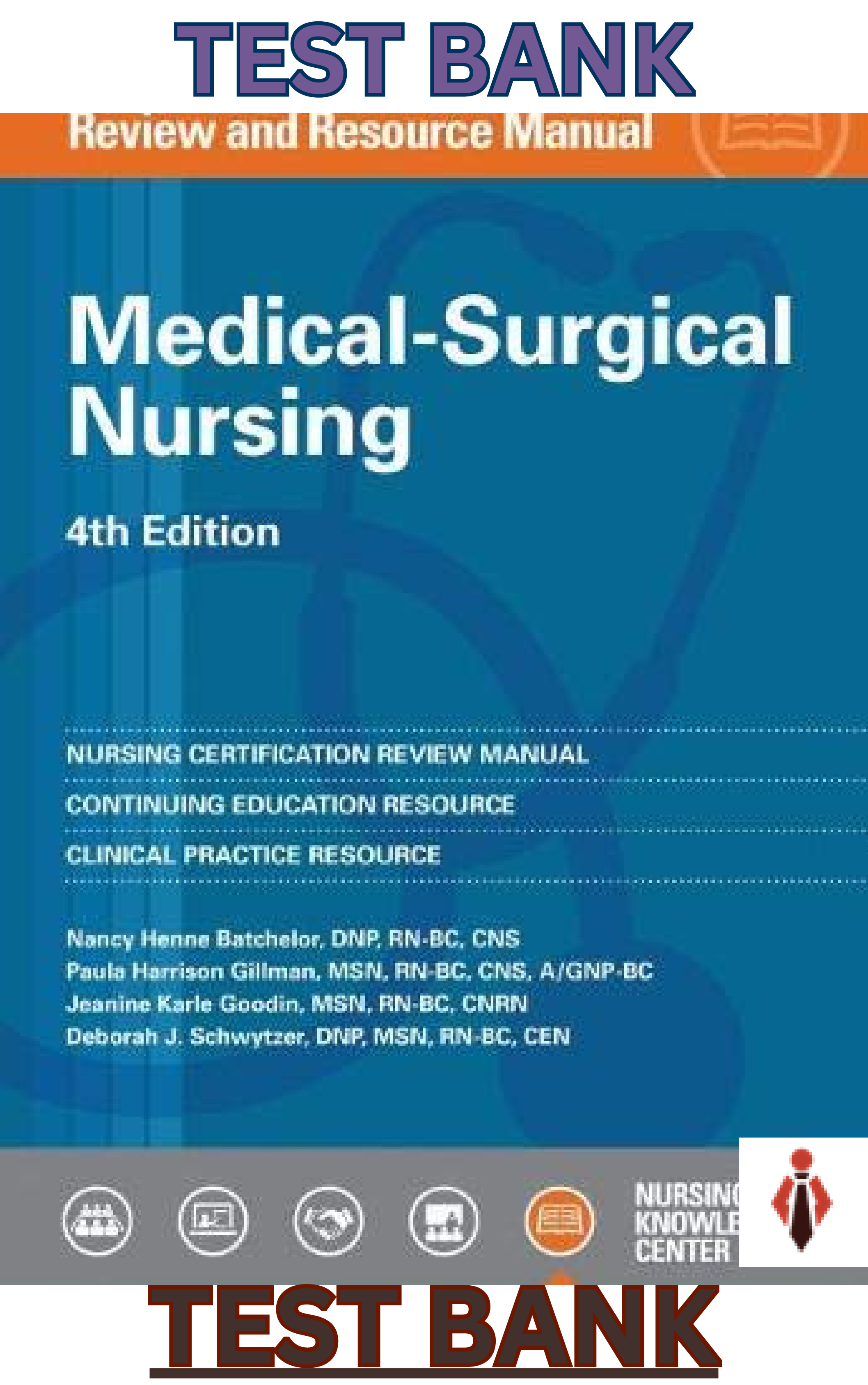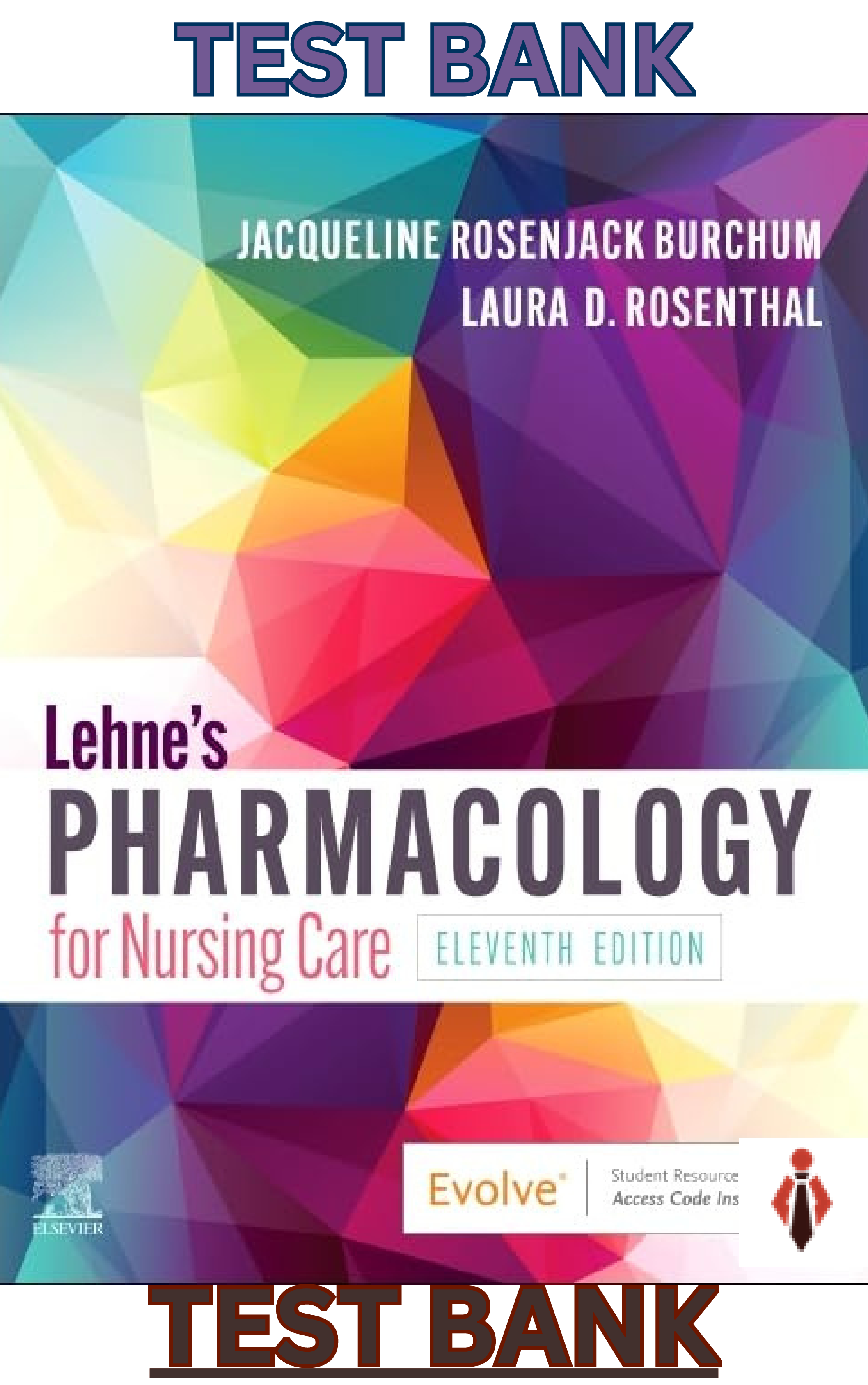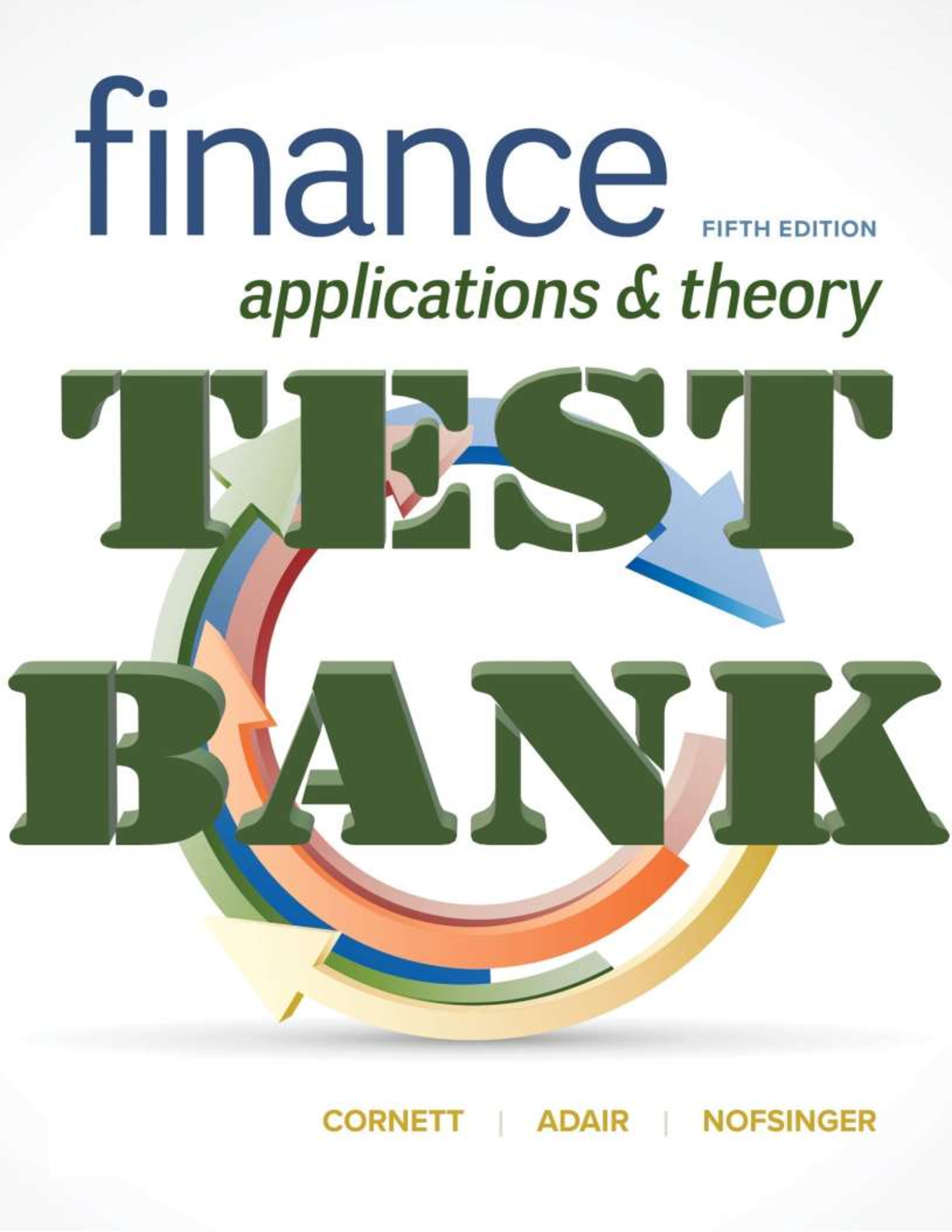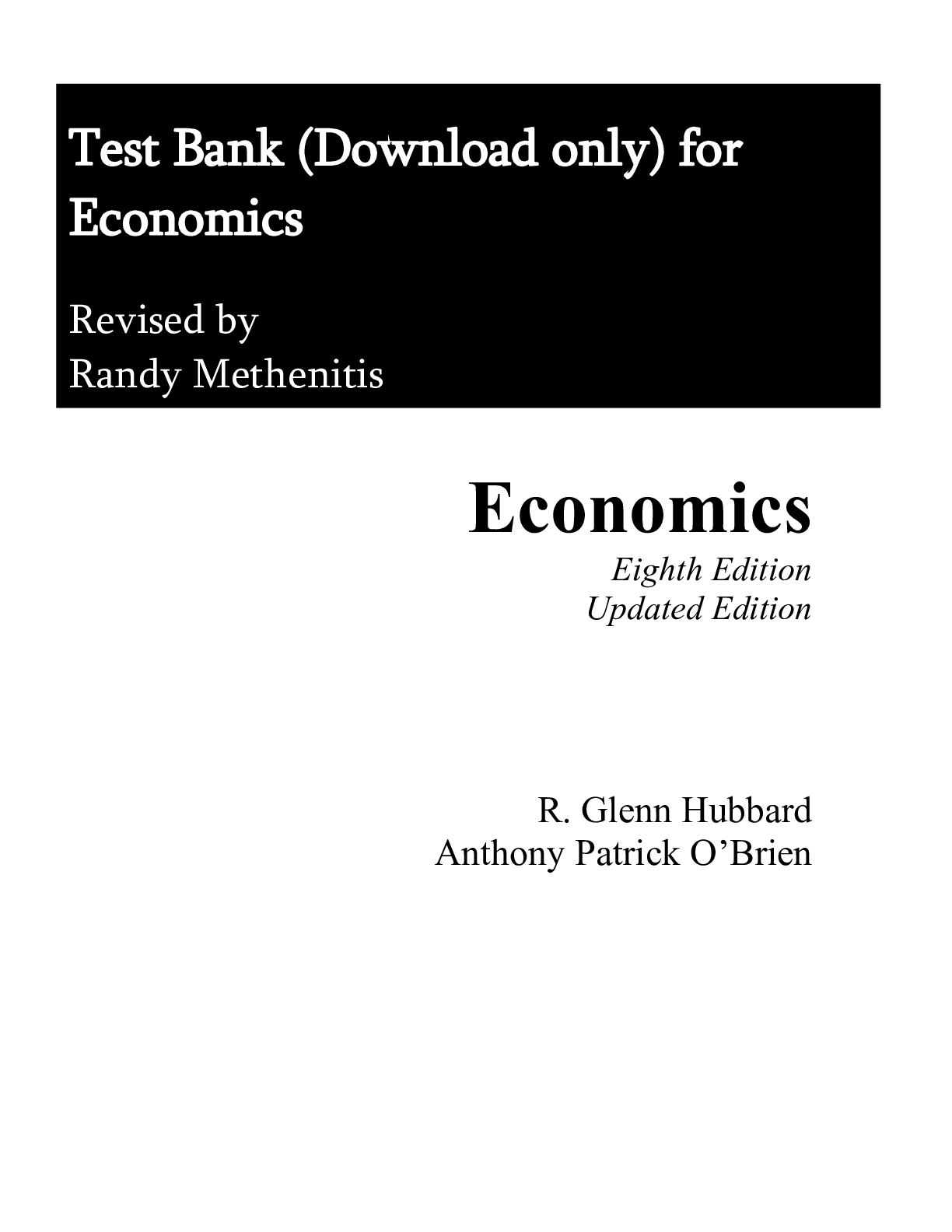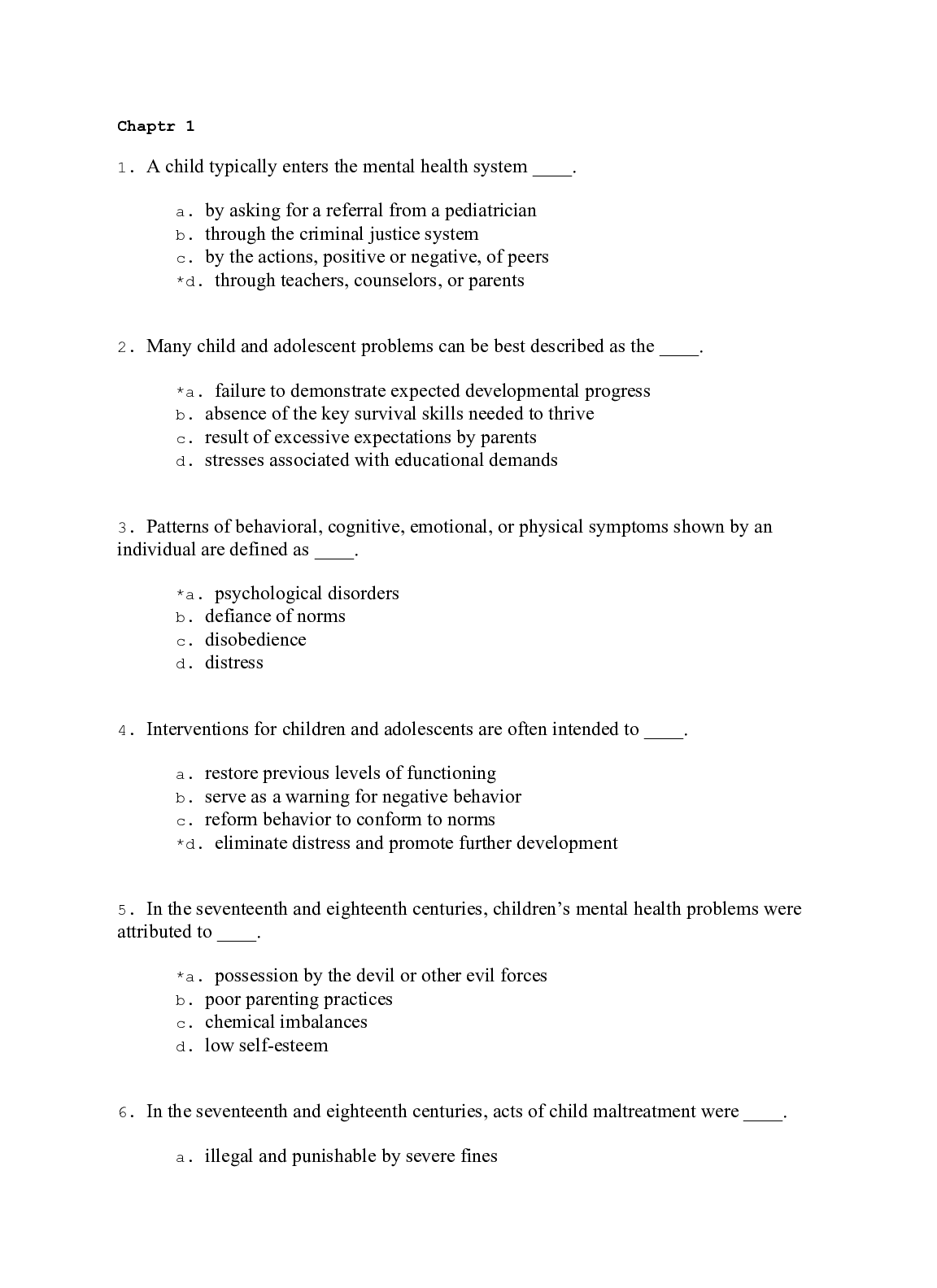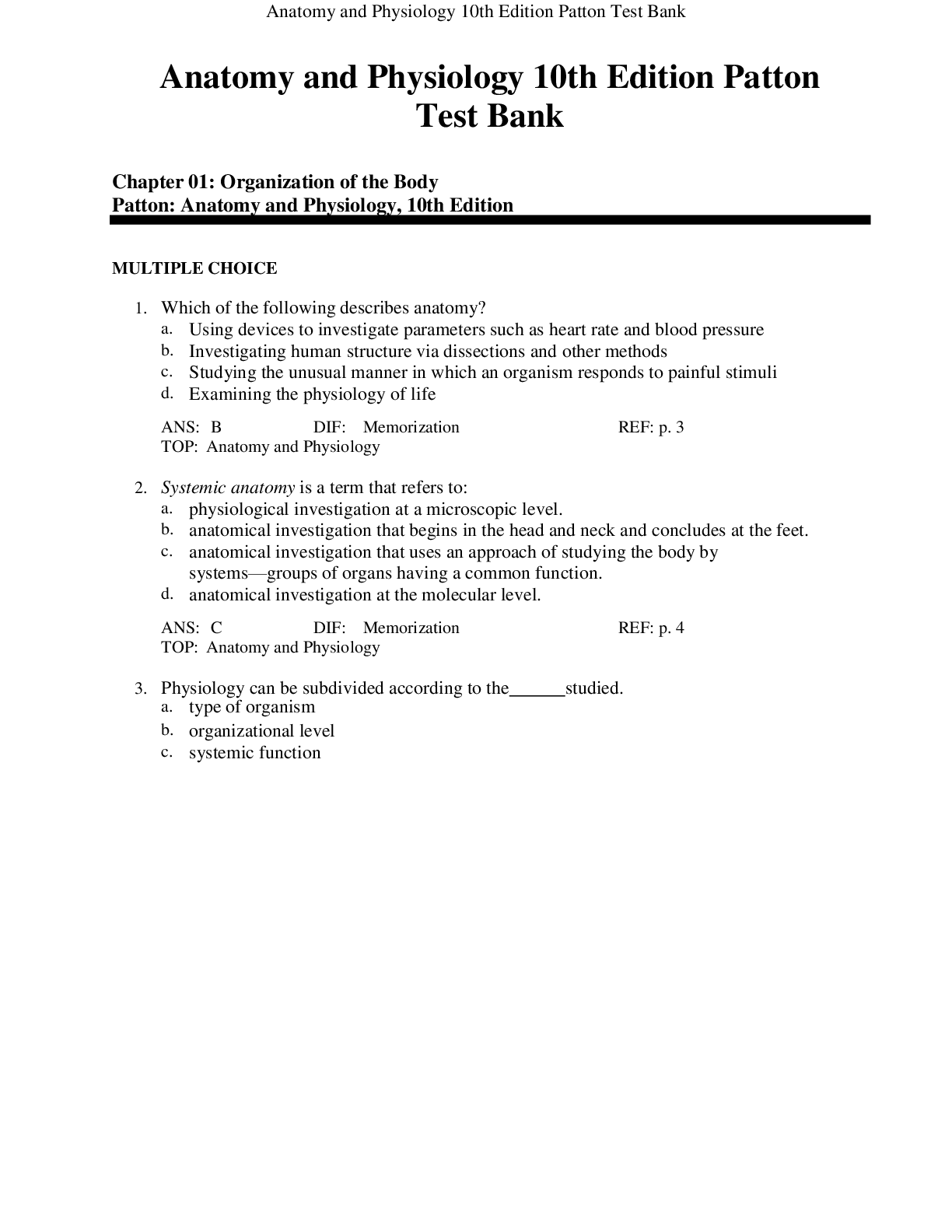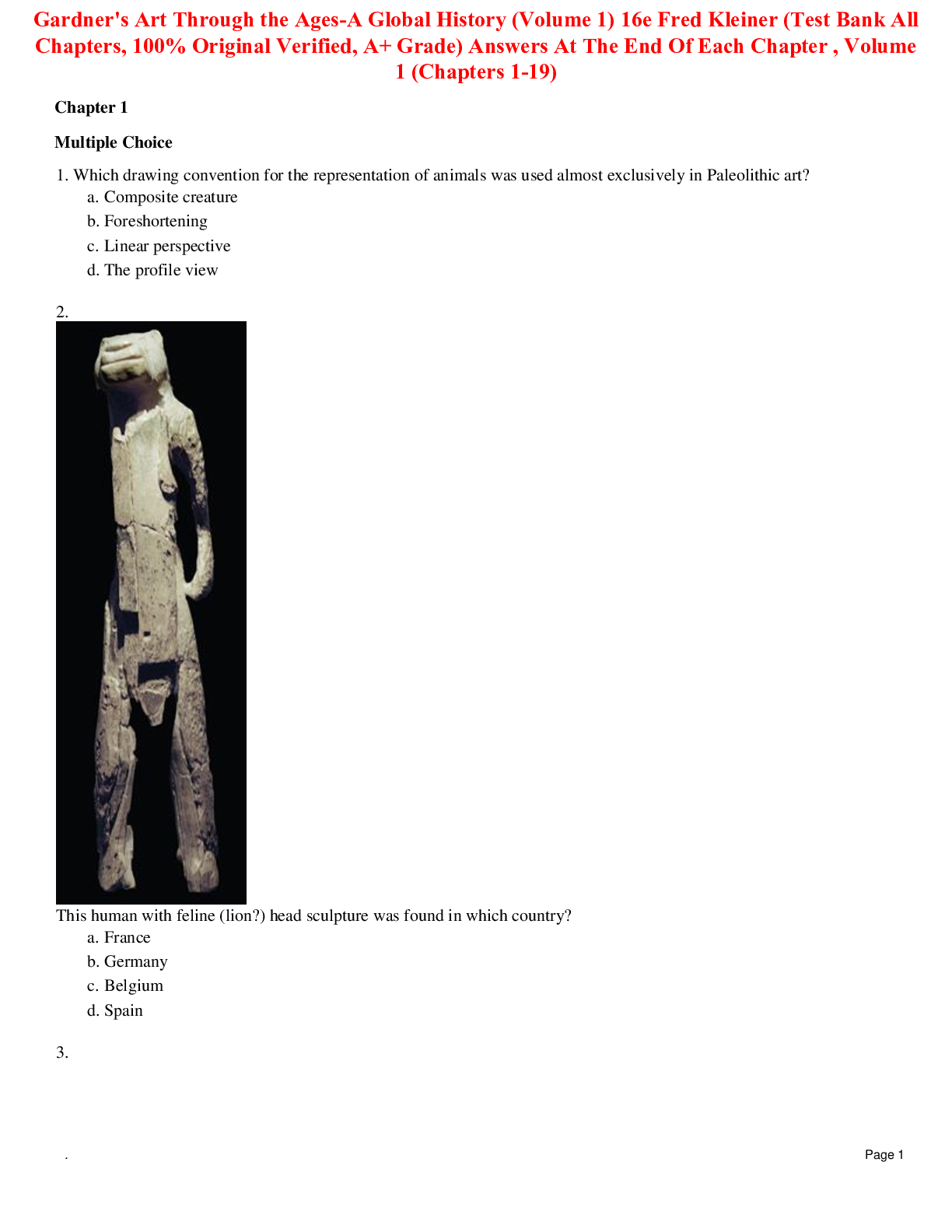Finance > TEST BANK > FIN 101 Mid Term-Financial Management Notes Questions And Answers;TOP SCORE./ BEST SOLUTION (All)
FIN 101 Mid Term-Financial Management Notes Questions And Answers;TOP SCORE./ BEST SOLUTION
Document Content and Description Below
1. "Capital" is sometimes defined as funds supplied to a firm by investors. T 2. The cost of capital used in capital budgeting should reflect the average cost of the various sources of long... -term funds a firm uses to acquire assets. T 3. The component costs of capital are market-determined variables in the sense that they are based on investors' required returns. T 4. Suppose you are the president of a small, publicly-traded corporation. Since you believe that your firm's stock price is temporarily depressed, all additional capital funds required during the current year will be raised using debt. In this case, the appropriate marginal cost of capital for use in capital budgeting during the current year is the after-tax cost of debt. F 5. The before-tax cost of debt, which is lower than the after-tax cost, is used as the component cost of debt for purposes of developing the firm's WACC. F 6. The cost of debt is equal to one minus the marginal tax rate multiplied by the average coupon rate on all outstanding debt. F 7. The cost of debt is equal to one minus the marginal tax rate multiplied by the interest rate on new debt. T 8. The cost of preferred stock to a firm must be adjusted to an after-tax figure because 70% of dividends received by a corporation may be excluded from the receiving corporation's taxable income. F 9. The cost of perpetual preferred stock is found as the preferred's annual dividend divided by the market price of the preferred stock. No adjustment is needed for taxes because preferred dividends, unlike interest on debt, is not deductible by the issuing firm. T 10. The cost of common equity obtained by retaining earnings is the rate of return the marginal stockholder requires on the firm's common stock. T 11. For capital budgeting and cost of capital purposes, the firm should always consider reinvested earnings as the first source of capital⎯i.e., use these funds first⎯because reinvested earnings have no cost to the firm. F 12. Funds acquired by the firm through retaining earnings have no cost because there are no dividend or interest payments associated with them, and no flotation costs are required to raise them, but capital raised by selling new stock or bonds does have a cost. F 13. The cost of equity raised by retaining earnings can be less than, equal to, or greater than the cost of external equity raised by selling new issues of common stock, depending on tax rates, flotation costs, the attitude of investors, and other factors. F 14. The firm's cost of external equity raised by issuing new stock is the same as the required rate of return on the firm's outstanding common stock. F 15. The higher the firm's flotation cost for new common equity, the more likely the firm is to use preferred stock, which has no flotation cost, and reinvested earnings, whose cost is the average return on the assets that are acquired. F 16. For capital budgeting and cost of capital purposes, the firm should assume that each dollar of capital is obtained in accordance with its target capital structure, which for many firms means partly as debt, partly as preferred stock, and partly common equity. T 17. In general, firms should use their weighted average cost of capital (WACC) to evaluate capital budgeting projects because most projects are funded with general corporate funds, which come from a variety of sources. However, if the firm plans to use only debt or only equity to fund a particular project, it should use the after-tax cost of that specific type of capital to evaluate that project. ANS: F In general, this statement is false, because the firm should be viewed as an ongoing entity, and using debt (or equity) to fund a given project will change the capital structure, and this factor should be recognized by basing the cost of capital for all projects on a target capital structure. Under some special circumstances, where a project is set up as a separate entity, then "project financing" may be used, and only the project's specific situation is considered. This is a specific situation, however, and not the "in general" case. 18. If a firm's marginal tax rate is increased, this would, other things held constant, lower the cost of debt used to calculate its WACC. T 19. The reason why reinvested earnings have a cost equal to rs is because investors think they can (i.e., expect to) earn rs on investments with the same risk as the firm's common stock, and if the firm does not think that it can earn rs on the earnings that it retains, it should distribute those earnings to its investors. Thus, the cost of reinvested earnings is based on the opportunity cost principle. T 20. When estimating the cost of equity by use of the CAPM, three potential problems are (1) whether to use long-term or short-term rates for rRF, (2) whether or not the historical beta is the beta that investors use when evaluating the stock, and (3) how to measure the market risk premium, RPM. These problems leave us unsure of the true value of rs. T 21. When estimating the cost of equity by use of the DCF method, the single biggest potential problem is to determine the growth rate that investors use when they estimate a stock's expected future rate of return. This problem leaves us unsure of the true value of rs. T 22. When estimating the cost of equity by use of the bond-yield-plus-riskpremium method, we can generally get a good idea of the interest rate on new long-term debt, but we cannot be sure that the risk premium we add is appropriate. This problem leaves us unsure of the true value of rs. T 23. The cost of external equity capital raised by issuing new common stock (re) is defined as follows, in words: "The cost of external equity equals the cost of equity capital from retaining earnings (rs), divided by one minus the percentage flotation cost required to sell the new stock, (1 − F)." ANS: F This statement is true only if the expected growth rate is zero. Here are some illustrative numbers that show that the statement is true if g = 0 but false otherwise. 24. If the expected dividend growth rate is zero, then the cost of external equity capital raised by issuing new common stock (re) is equal to the cost of equity capital from retaining earnings (rs) divided by one minus the percentage flotation cost required to sell the new stock, (1 − F). If the expected growth rate is not zero, then the cost of external equity must be found using a different formula. ANS: T This statement is true. Here are some illustrative numbers to demonstrate this point. 25. Suppose the debt ratio (D/TA) is 50%, the interest rate on new debt is 8%, the current cost of equity is 16%, and the tax rate is 40%. An increase in the debt ratio to 60% would decrease the weighted average cost of capital (WACC). F 26. Firms raise capital at the total corporate level by retaining earnings and by obtaining funds in the capital markets. They then provide funds to their different divisions for investment in capital projects. The divisions may vary in risk, and the projects within the divisions may also vary in risk. Therefore, it is conceptually correct to use different risk-adjusted costs of capital for different capital budgeting projects. T 27. If a firm is privately owned, and its stock is not traded in public markets, then we cannot measure its beta for use in the CAPM model, we cannot observe its stock price for use in the DCF model, and we don't know what the risk premium is for use in the bond-yield-plus-risk-premium method. All this makes it especially difficult to estimate the cost of equity for a private company. ANS: T True, but data on comparable publicly owned firms can often be obtained and used as proxies for private firms. 28. The cost of debt, rd, is normally less than rs, so rd(1 − T) will normally be much less than rs. Therefore, as long as the firm is not completely debt financed, the weighted average cost of capital (WACC) will normally be greater than rd(1 − T). T 29. The lower the firm's tax rate, the lower will be its after-tax cost of debt and also its WACC, other things held constant. F 30. The text identifies three methods for estimating the cost of common stock from reinvested earnings (not newly issued stock): the CAPM method, the DCF method, and the bond-yield-plus-risk-premium method. However, only the DCF method is widely used in practice. F 31. The text identifies three methods for estimating the cost of common stock from reinvested earnings (not newly issued stock): the CAPM method, the DCF method, and the bond-yield-plus-risk-premium method. However, only the CAPM method always provides an accurate and reliable estimate. ANS: F None of the methods always provides accurate and reliable estimates. With the CAPM, we don't know the beta that investors are using, we are not totally sure of what rRF to use, and we don't know if the CAPM is truly correct. 32. The text identifies three methods for estimating the cost of common stock from reinvested earnings (not newly issued stock): the CAPM method, the DCF method, and the bond-yield-plus-risk-premium method. Since we cannot be sure that the estimate obtained with any of these methods is correct, it is often appropriate to use all three methods, then consider all three estimates, and end up using a judgmental estimate when calculating the WACC. T 33. Since 70% of the preferred dividends received by a corporation are excluded from taxable income, the component cost of equity for a company that pays half of its earnings out as common dividends and half as preferred dividends should, theoretically, be Cost of equity = rs(0.30)(0.50) + rps(1 − T)(0.70)(0.50). ANS: F The preferred dividend exclusion is a benefit to the holder of the preferred, not the issuer; hence, this statement is not true. It actually is just nonsense anyway! 34. If expectations for long-term inflation rose, but the slope of the SML remained constant, this would have a greater impact on the required rate of return on equity, rs, than on the interest rate on long-term debt, rd, for most firms. Therefore, the percentage point increase in the cost of equity would be greater than the increase in the interest rate on long-term debt. ANS: F Increased inflation results in a parallel upward shift in the SML, which means equal percentage increases in the required return on debt and equity. 35. If investors' aversion to risk rose, causing the slope of the SML to increase, this would have a greater impact on the required rate of return on equity, rs, than on the interest rate on long-term debt, rd, for most firms. Other things held constant, this would lead to an increase in the use of debt and a decrease in the use of equity. However, other things would not stay constant if firms used a lot more debt, as that would increase the riskiness of both debt and equity and thus limit the shift toward debt. T 36. Which of the following is NOT a capital component when calculating the weighted average cost of capital (WACC) for use in capital budgeting? a. Accounts payable. b. Common stock "raised" by reinvesting earnings. c. Common stock raised by new issues. d. Preferred stock. e. Long-term debt. A 37. With its current financial policies, Flagstaff Inc. will have to issue new common stock to fund its capital budget. Since new stock has a higher cost than reinvested earnings, Flagstaff would like to avoid issuing new stock. Which of the following actions would REDUCE its need to issue new common stock? a. Increase the percentage of debt in the target capital structure. b. Increase the proposed capital budget. c. Reduce the amount of short-term bank debt in order to increase the current ratio. d. Reduce the percentage of debt in the target capital structure. e. Increase the dividend payout ratio for the upcoming year. ANS: A Statement a is correct, because if more debt is used, then less equity will be needed to fund the capital budget, so the need for a stock issue would be reduced. 38. Burnham Brothers Inc. has no retained earnings since it has always paid out all of its earnings as dividends. This same situation is expected to persist in the future. The company uses the CAPM to calculate its cost of equity, and its target capital structure consists of common stock, preferred stock, and debt. Which of the following events would REDUCE its WACC? a. The flotation costs associated with issuing new common stock increase. b. The company's beta increases. c. Expected inflation increases. d. The flotation costs associated with issuing preferred stock increase. e. The market risk premium declines. E 39. For a typical firm, which of the following sequences is CORRECT? All rates are after taxes, and assume that the firm operates at its target capital structure. a. re > rs > WACC > rd. b. WACC > re > rs > rd. c. rd > re > rs > WACC. d. WACC > rd > rs > re. e. rs > re > rd > WACC. A 40. When working with the CAPM, which of the following factors can be determined with the most precision? a. The beta coefficient, bi, of a relatively safe stock. b. The most appropriate risk-free rate, rRF. c. The expected rate of return on the market, rM. d. The beta coefficient of "the market," which is the same as the beta of an average stock. e. The market risk premium (RPM). ANS: D By definition, both the market and an average stock have betas of 1.0. Since we know this to be the case, we can obviously determine beta for the market or an average stock with precision. 41. Bloom and Co. has no debt or preferred stock⎯it uses only equity capital, and has two equally-sized divisions. Division X's cost of capital is 10.0%, Division Y's cost is 14.0%, and the corporate (composite) WACC is 12.0%. All of Division X's projects are equally risky, as are all of Division Y's projects. However, the projects of Division X are less risky than those of Division Y. Which of the following projects should the firm accept? a. A Division Y project with a 12% return. b. A Division X project with an 11% return. c. A Division X project with a 9% return. d. A Division Y project with an 11% return. e. A Division Y project with a 13% return. ANS: B The correct answer is statement b. Division X should accept only projects with returns greater than 10%, while Division Y should accept only projects with returns greater than 14%. Only statement b meets this criterion. 42. Taylor Inc. estimates that its average-risk projects have a WACC of 10%, its below-average risk projects have a WACC of 8%, and its above-average risk projects have a WACC of 12%. Which of the following projects (A, B, and C) should the company accept? a. Project C, which is of above-average risk and has a return of 11%. b. Project A, which is of average risk and has a return of 9%. c. None of the projects should be accepted. d. All of the projects should be accepted. e. Project B, which is of below-average risk and has a return of 8.5%. ANS: E Project B has a return greater than its risk-adjusted cost of capital, so it should be accepted. 43. Weatherall Enterprises has no debt or preferred stock⎯it is an all-equity firm⎯and has a beta of 2.0. The chief financial officer is evaluating a project with an expected return of 14%, before any risk adjustment. The risk-free rate is 5%, and the market risk premium is 4%. The project being evaluated is riskier than an average project, in terms of both its beta risk and its total risk. Which of the following statements is CORRECT? a. The project should definitely be rejected because its expected return (before risk adjustment) is less than its required return. b. Riskier-than-average projects should have their expected returns increased to reflect their higher risk. Clearly, this would make the project acceptable regardless of the amount of the adjustment. c. The accept/reject decision depends on the firm's risk-adjustment policy. If Weatherall's policy is to increase the required return on a riskier-than-average project to 3% over rS, then it should reject the project. d. Capital budgeting projects should be evaluated solely on the basis of their total risk. Thus, insufficient information has been provided to make the accept/reject decision. e. The project should definitely be accepted because its expected return (before any risk adjustments) is greater than its required return. ANS: C Statement c is correct. Here is the proof: rs = 5% + 4%(2.0) = 5% + 8% = 13%. Required return for risky projects = 13% + 3% = 16%. Project return = 14% < adjusted rs = 16%. Thus, the project should be rejected. 44. The Anderson Company has equal amounts of low-risk, average-risk, and high-risk projects. The firm's overall WACC is 12%. The CFO believes that this is the correct WACC for the company's average-risk projects, but that a lower rate should be used for lower-risk projects and a higher rate for higher-risk projects. The CEO disagrees, on the grounds that even though projects have different risks, the WACC used to evaluate each project should be the same because the company obtains capital for all projects from the same sources. If the CEO's position is accepted, what is likely to happen over time? a. The company will take on too many low-risk projects and reject too many highrisk projects. b. Things will generally even out over time, and, therefore, the firm's risk should remain constant over time. c. The company's overall WACC should decrease over time because its stock price should be increasing. d. The CEO's recommendation would maximize the firm's intrinsic value. e. The company will take on too many high-risk projects and reject too many lowrisk projects. ANS: E Low-risk projects will tend to have low expected returns and vice versa for high-risk projects due to competition in the economy. By not adjusting the cost of capital for project risk, the firm will tend to reject low-risk projects even though they earn higher returns than their risk-adjusted costs of capital, and vice versa for high-risk projects. In addition, as the firm takes on more high-risk projects, its correct WACC will increase over time. Therefore, statement e is correct. 45. Suppose Acme Industries correctly estimates its WACC at a given point in time and then uses that same cost of capital to evaluate all projects for the next 10 years, then the firm will most likely a. become less risky over time, and this will maximize its intrinsic value. b. accept too many low-risk projects and too few high-risk projects. c. become more risky and also have an increasing WACC. Its intrinsic value will not be maximized. d. continue as before, because there is no reason to expect its risk position or value to change over time as a result of its use of a single cost of capital. e. become riskier over time, but its intrinsic value will be maximized. ANS: C Low-risk projects will tend to have low expected returns and vice versa for high-risk projects due to competition in the economy. By not adjusting the cost of capital for project risk, the firm will tend to reject low-risk projects even though they earn higher returns than their risk-adjusted costs of capital, and vice versa for high-risk projects. As the firm takes on more high-risk projects, its true WACC will increase over time. Of course, the true WACC might change over time due to changes in market conditions, but that could cause the true WACC to either rise or decline. Therefore, statement c is correct. 46. Which of the following statements is CORRECT? a. All else equal, an increase in a company's stock price will increase its marginal cost of reinvested earnings (not newly issued stock), rs. b. All else equal, an increase in a company's stock price will increase its marginal cost of new common equity, re. c. Since the money is readily available, the after-tax cost of reinvested earnings (not newly issued stock) is usually much lower than the after-tax cost of debt. d. If a company's tax rate increases but the YTM on its noncallable bonds remains the same, the after-tax cost of its debt will fall. e. When calculating the cost of preferred stock, a company needs to adjust for taxes, because preferred stock dividends are deductible by the paying corporation. ANS: D Statement d is true, because the after-tax cost of debt is rd(1 − T). So, if rd remains constant but T increases, rd(1 − T) will decline. The other statements are false. 47. Which of the following statements is CORRECT? a. When calculating the cost of preferred stock, companies must adjust for taxes, because dividends paid on preferred stock are deductible by the paying corporation. b. Because of tax effects, an increase in the risk-free rate will have a greater effect on the after-tax cost of debt than on the cost of common stock as measured by the CAPM. c. If a company's beta increases, this will increase the cost of equity used to calculate the WACC, but only if the company does not have enough reinvested earnings to take care of its equity financing and hence must issue new stock. d. Higher flotation costs reduce investors' expected returns, and that leads to a reduction in a company's WACC. e. When calculating the cost of debt, a company needs to adjust for taxes, because interest payments are deductible by the paying corporation. ANS: E Statement e is true; interest payments on debt are tax deductible. The other statements are false. 48. Which of the following statements is CORRECT? a. We should use historical measures of the component costs from prior financings that are still outstanding when estimating a company's WACC for capital budgeting purposes. b. The cost of new equity (re) could possibly be lower than the cost of reinvested earnings (rs) if the market risk premium, risk-free rate, and the company's beta all decline by a sufficiently large amount. c. A firm's cost of reinvesting earnings is the rate of return stockholders require on a firm's common stock. d. The component cost of preferred stock is expressed as rp(1 − T), because preferred stock dividends are treated as fixed charges, similar to the treatment of interest on debt. e. In the WACC calculation, we must adjust the cost of preferred stock (the market yield) to reflect the fact that 70% of the dividends received by corporate investors are excluded from their taxable income. C 49. Which of the following statements is CORRECT? a. The percentage flotation cost associated with issuing new common equity is typically smaller than the flotation cost for new debt. b. The WACC as used in capital budgeting is an estimate of the cost of all the capital a company has raised to acquire its assets. c. There is an "opportunity cost" associated with using reinvested earnings, hence they are not "free." d. The WACC as used in capital budgeting would be simply the after-tax cost of debt if the firm plans to use only debt to finance its capital budget during the coming year. e. The WACC as used in capital budgeting is an estimate of a company's before-tax cost of capital. C 50. Which of the following statements is CORRECT? a. WACC calculations should be based on the before-tax costs of all the individual capital components. b. Flotation costs associated with issuing new common stock normally reduce the WACC. c. If a company's tax rate increases, then, all else equal, its weighted average cost of capital will decline. d. An increase in the risk-free rate will normally lower the marginal costs of both debt and equity financing. e. A change in a company's target capital structure cannot affect its WACC. ANS: C Statement c is true, because the cost of debt for WACC purposes = rd(1 − T), so if T increases, then rd(1 − T) declines. 51. Which of the following statements is CORRECT? a. The after-tax cost of debt usually exceeds the after-tax cost of equity. b. For a given firm, the after-tax cost of debt is always more expensive than the after-tax cost of non-convertible preferred stock. c. Retained earnings that were generated in the past and are reported on the firm's balance sheet are available to finance the firm's capital budget during the coming year. d. The WACC that should be used in capital budgeting is the firm's marginal, aftertax cost of capital. e. The WACC is calculated using before-tax costs for all components. D 52. Which of the following statements is CORRECT? Assume a company's target capital structure is 50% debt and 50% common equity. a. The WACC is calculated on a before-tax basis. b. The WACC exceeds the cost of equity. c. The cost of equity is always equal to or greater than the cost of debt. d. The cost of reinvested earnings typically exceeds the cost of new common stock. e. The interest rate used to calculate the WACC is the average after-tax cost of all the company's outstanding debt as shown on its balance sheet. Statement c is true, because equity is more risky than debt and hence investors require a higher return on equity. Also, interest on debt is deductible, and this further reduces the cost of debt. The other statements are false. 53. Which of the following statements is CORRECT? a. The tax-adjusted cost of debt is always greater than the interest rate on debt, provided the company does in fact pay taxes. b. If a company assigns the same cost of capital to all of its projects regardless of each project's risk, then the company is likely to reject some safe projects that it actually should accept and to accept some risky projects that it should reject. c. Because no flotation costs are required to obtain capital as reinvested earnings, the cost of reinvested earnings is generally lower than the after-tax cost of debt. d. Higher flotation costs tend to reduce the cost of equity capital. e. Since debt capital can cause a company to go bankrupt but equity capital cannot, debt is riskier than equity, and thus the after-tax cost of debt is always greater than the cost of equity. B 54. The Tierney Group has two divisions of equal size: an office furniture manufacturing division and a data processing division. Its CFO believes that stand-alone data processor companies typically have a WACC of 9%, while stand-alone furniture manufacturers typically have a 13% WACC. She also believes that the data processing and manufacturing divisions have the same risk as their typical peers. Consequently, she estimates that the composite, or corporate, WACC is 11%. A consultant has suggested using a 9% hurdle rate for the data processing division and a 13% hurdle rate for the manufacturing division. However, the CFO disagrees, and she has assigned an 11% WACC to all projects in both divisions. Which of the following statements is CORRECT? a. The decision not to adjust for risk means, in effect, that it is favoring the data processing division. Therefore, that division is likely to become a larger part of the consolidated company over time. b. The decision not to adjust for risk means that the company will accept too many projects in the manufacturing division and too few in the data processing division. This will lead to a reduction in the firm's intrinsic value over time. c. The decision not to risk-adjust means that the company will accept too many projects in the data processing business and too few projects in the manufacturing business. This will lead to a reduction in its intrinsic value over time. d. The decision not to risk-adjust means that the company will accept too many projects in the manufacturing business and too few projects in the data processing business. This may affect the firm's capital structure but it will not affect its intrinsic value. e. While the decision to use just one WACC will result in its accepting more projects in the manufacturing division and fewer projects in its data processing division than if it followed the consultant's recommendation, this should not affect the firm's intrinsic value. ANS: B By not making the risk adjustment, the firm will accept too many projects in the manufacturing division and too few in the data processing division. As a result, the company will become riskier overall, raising its cost of capital. Investors will discount the firm's cash flows at a higher rate, and the firm's value will fall. Therefore, statement b is true and the other statements are false. 55. Careco Company and Audaco Inc are identical in size and capital structure. However, the riskiness of their assets and cash flows are somewhat different, resulting in Careco having a WACC of 10% and Audaco a WACC of 12%. Careco is considering Project X, which has an IRR of 10.5% and is of the same risk as a typical Careco project. Audaco is considering Project Y, which has an IRR of 11.5% and is of the same risk as a typical Audaco project. Now assume that the two companies merge and form a new company, Careco/Audaco Inc. Moreover, the new company's market risk is an average of the pre-merger companies' market risks, and the merger has no impact on either the cash flows or the risks of Projects X and Y. Which of the following statements is CORRECT? a. If evaluated using the correct post-merger WACC, Project X would have a negative NPV. b. After the merger, Careco/Audaco would have a corporate WACC of 11%. Therefore, it should reject Project X but accept Project Y. c. Careco/Audaco's WACC, as a result of the merger, would be 10%. d. After the merger, Careco/Audaco should select Project Y but reject Project X. If the firm does this, its corporate WACC will fall to 10.5%. e. If the firm evaluates these projects and all other projects at the new overall corporate WACC, it will probably become riskier over time. E 56. Which of the following statements is CORRECT? a. A cost should be assigned to reinvested earnings due to the opportunity cost principle, which refers to the fact that the firm's stockholders would themselves expect to earn a return on earnings that were distributed rather than retained and reinvested. b. No cost should be assigned to reinvested earnings because the firm does not have to pay anything to raise them. They are generated as cash flows by operating assets that were raised in the past; hence, they are "free." c. Suppose a firm has been losing money and thus is not paying taxes, and this situation is expected to persist into the foreseeable future. In this case, the firm's before-tax and after-tax costs of debt for purposes of calculating the WACC will both be equal to the interest rate on the firm's currently outstanding debt, provided that debt was issued during the past 5 years. d. If a firm has enough reinvested earnings to fund its capital budget for the coming year, then there is no need to estimate either a cost of equity or a WACC. e. The component cost of preferred stock is expressed as rp(1 − T). This follows because preferred stock dividends are treated as fixed charges, and as such they can be deducted by the issuer for tax purposes. A 57. Which of the following statements is CORRECT? a. The after-tax cost of debt that should be used as the component cost when calculating the WACC is the average after-tax cost of all the firm's outstanding debt. b. Suppose some of a publicly-traded firm's stockholders are not diversified; they hold only the one firm's stock. In this case, the CAPM approach will result in an estimated cost of equity that is too low in the sense that if it is used in capital budgeting, projects will be accepted that will reduce the firm's intrinsic value. c. The cost of equity is generally harder to measure than the cost of debt because there is no stated, contractual cost number on which to base the cost of equity. d. The bond-yield-plus-risk-premium approach is the most sophisticated and objective method for estimating a firm's cost of equity capital. e. The cost of capital used to evaluate a project should be the cost of the specific type of financing used to fund that project, i.e., it is the after-tax cost of debt if debt is to be used to finance the project or the cost of equity if the project will be financed with equity. C 58. Which of the following statements is CORRECT? a. The DCF model is generally preferred by academics and financial executives over other models for estimating the cost of equity. This is because of the DCF model's logical appeal and also because accurate estimates for its key inputs, the dividend yield and the growth rate, are easy to obtain. b. The bond-yield-plus-risk-premium approach to estimating the cost of equity may not always be accurate, but it has the advantage that its two key inputs, the firm's own cost of debt and its risk premium, can be found by using standardized and objective procedures. c. Surveys indicate that the CAPM is the most widely used method for estimating the cost of equity. However, other methods are also used because CAPM estimates may be subject to error, and people like to use different methods as checks on one another. If all of the methods produce similar results, this increases the decision maker's confidence in the estimated cost of equity. d. The DCF model is preferred by academics and finance practitioners over other cost of capital models because it correctly recognizes that the expected return on a stock consists of a dividend yield plus an expected capital gains yield. e. Although some methods used to estimate the cost of equity are subject to severe limitations, the CAPM is a simple, straightforward, and reliable model that consistently produces accurate cost of equity estimates. In particular, academics and corporate finance people generally agree that its key inputs⎯beta, the riskfree rate, and the market risk premium⎯can be estimated with little error. C 59. Which of the following statements is CORRECT? a. If the calculated beta underestimates the firm's true investment risk⎯i.e., if the forward-looking beta that investors think exists exceeds the historical beta⎯then the CAPM method based on the historical beta will produce an estimate of rs and thus WACC that is too high. b. Beta measures market risk, which is, theoretically, the most relevant risk measure for a publicly-owned firm that seeks to maximize its intrinsic value. This is true even if not all of the firm's stockholders are well diversified. c. An advantage shared by both the DCF and CAPM methods when they are used to estimate the cost of equity is that they are both "objective" as opposed to "subjective," hence little or no judgment is required. d. The specific risk premium used in the CAPM is the same as the risk premium used in the bond-yield-plus-risk-premium approach. e. The discounted cash flow method of estimating the cost of equity cannot be used unless the growth rate, g, is expected to be constant forever. B 60. Which of the following statements is CORRECT? a. The WACC is calculated using a before-tax cost for debt that is equal to the interest rate that must be paid on new debt, along with the after-tax costs for common stock and for preferred stock if it is used. b. An increase in the risk-free rate is likely to reduce the marginal costs of both debt and equity. c. The relevant WACC can change depending on the amount of funds a firm raises during a given year. Moreover, the WACC at each level of funds raised is a weighted average of the marginal costs of each capital component, with the weights based on the firm's target capital structure. d. Beta measures market risk, which is generally the most relevant risk measure for a publicly-owned firm that seeks to maximize its intrinsic value. However, this is not true unless all of the firm's stockholders are well diversified. e. The bond-yield-plus-risk-premium approach to estimating the cost of common equity involves adding a risk premium to the interest rate on the company's own long-term bonds. The size of the risk premium for bonds with different ratings is published daily in The Wall Street Journal. ANS: C Statement c is true⎯the WACC will increase if the firm raises more funds than can be supported by reinvested earnings. 61. Which of the following statements is CORRECT? a. Since its stockholders are not directly responsible for paying a corporation's income taxes, corporations should focus on before-tax cash flows when calculating the WACC. b. An increase in a firm's tax rate will increase the component cost of debt, provided the YTM on the firm's bonds is not affected by the change in the tax rate. c. When the WACC is calculated, it should reflect the costs of new common stock, reinvested earnings, preferred stock, long-term debt, short-term bank loans if the firm normally finances with bank debt, and accounts payable if the firm normally has accounts payable on its balance sheet. d. If a firm has been suffering accounting losses that are expected to continue into the foreseeable future, and therefore its tax rate is zero, then it is possible for the after-tax cost of preferred stock to be less than the after-tax cost of debt. e. Since the costs of internal and external equity are related, an increase in the flotation cost required to sell a new issue of stock will increase the cost of reinvested earnings. ANS: D Statement d is true. The firm would receive no tax savings on interest, so its cost of debt would not be reduced by the tax factor. However, corporate investors would be able to deduct 70% of the preferred dividends they receive, which would make them willing to accept a lower beforetax yield on preferred stock than on bonds. Put another way, the market yield on this firm's preferred could be lower than the interest rate on its debt because of the 70% exclusion; however, with a zero tax rate there would be no reduction in the firm's cost of debt. 62. Which of the following statements is CORRECT? Assume that the firm is a publicly-owned corporation and is seeking to maximize shareholder wealth. a. If a firm's managers want to maximize the value of their firm's stock, they should, in theory, concentrate on project risk as measured by the standard deviation of the project's expected future cash flows. b. If a firm evaluates all projects using the same cost of capital, and the CAPM is used to help determine that cost, then its risk as measured by beta will probably decline over time. c. Projects with above-average risk typically have higher than average expected returns. Therefore, to maximize a firm's intrinsic value, its managers should favor high-beta projects over those with lower betas. d. Project A has a standard deviation of expected returns of 20%, while Project B's standard deviation is only 10%. A's returns are negatively correlated with both the firm's other assets and the returns on most stocks in the economy, while B's returns are positively correlated. Therefore, Project A is less risky to a firm and should be evaluated with a lower cost of capital. e. If a firm has a beta that is less than 1.0, say 0.9, this would suggest that the expected returns on its assets are negatively correlated with the returns on most other firms' assets. ANS: D The fact that A's returns are negatively correlated means that it serves as a sort of insurance policy to the firm. The fact that its SD is high is actually good, because the negative correlation will cause the project's beta versus the market and also with the firm's other assets to be relatively low, denoting a low risk and thus justifying a relatively low cost of capital. This answer is theoretically always true, and it is especially true if the firm is large, has many projects, and Project A is not a "bet the company" project. 63. Firm J's earnings and stock price tend to move up and down with other firms in the S&P 500, while Firm F's earnings and stock price move counter cyclically with J and other S&P companies. Both J and F estimate their costs of equity using the CAPM, they have identical market values, their standard deviations of returns are identical, and they both finance only with common equity. Which of the following statements is CORRECT? a. J and F should have identical WACCs because their risks as measured by the standard deviation of returns are identical. b. If J and F merge, then the merged firm MW should have a WACC that is a simple average of J's and F's WACCs. c. Without additional information, it is impossible to predict what the merged firm's WACC would be if J and F merged. d. Since J and F move counter cyclically to one another, if they merged, the merged firm's WACC would be less than the simple average of the two firms' WACCs. e. J should have the lower WACC because it is like most other companies, and investors like that fact. ANS: B Statement b is true. The merged firm would have a beta that is a simple average of J's and F's betas, and that would result in a cost of equity that is an average of the two firms' costs of equity. Since they are financed only with equity, their WACCs could also be averaged to find the merged firm's WACC. 64. Perpetual preferred stock from Franklin Inc. sells for $97.50 per share, and it pays an $8.50 annual dividend. If the company were to sell a new preferred issue, it would incur a flotation cost of 4.00% of the price paid by investors. What is the company's cost of preferred stock for use in calculating the WACC? a. 8.72% b. 9.08% c. 9.44% d. 9.82% e. 10.22% ANS: B Preferred stock price $97.50 Preferred dividend $8.50 Flotation cost 4.00% rp = Dp/(Pp(1 − F)) 9.08% 65. A company's perpetual preferred stock currently sells for $92.50 per share, and it pays an $8.00 annual dividend. If the company were to sell a new preferred issue, it would incur a flotation cost of 5.00% of the issue price. What is the firm's cost of preferred stock? a. 7.81% b. 8.22% c. 8.65% d. 9.10% e. 9.56% ANS: D Preferred stock price $92.50 Preferred dividend $8.00 Flotation cost 5.00% rp = Dp/(Pp(1 − F)) 9.10% 66. Adams Inc. has the following data: rRF = 5.00%; RPM = 6.00%; and b = 1.05. What is the firm's cost of common from reinvested earnings based on the CAPM? a. 11.30% b. 11.64% c. 11.99% d. 12.35% e. 12.72% ANS: A rRF 5.00% RPM 6.00% b 1.05 rs = rRF + (RPM × b) 11.30% 67. You have been hired as a consultant by Feludi Inc.'s CFO, who wants you to help her estimate the cost of capital. You have been provided with the following data: rRF = 4.10%; RPM = 5.25%; and b = 1.30. Based on the CAPM approach, what is the cost of common from reinvested earnings? a. 9.67% b. 9.97% c. 10.28% d. 10.60% e. 10.93% ANS: E rRF 4.10% RPM 5.25% b 1.30 rs = rRF + (RPM × b) 10.925% 68. As a consultant to Basso Inc., you have been provided with the following data: D1 = $0.67; P0 = $27.50; and g = 8.00% (constant). What is the cost of common from reinvested earnings based on the DCF approach? a. 9.42% b. 9.91% c. 10.44% d. 10.96% e. 11.51% ANS: C D1 $0.67 P0 $27.50 g 8.00% rs = D1/P0 + g 10.44% 69. To help them estimate the company's cost of capital, Smithco has hired you as a consultant. You have been provided with the following data: D1 = $1.45; P0 = $22.50; and g = 6.50% (constant). Based on the DCF approach, what is the cost of common from reinvested earnings? a. 11.10% b. 11.68% c. 12.30% d. 12.94% e. 13.59% ANS: D D1 $1.45 P0 $22.50 g 6.50% rs = D1/P0 + g 12.94% 70. Your consultant firm has been hired by Eco Brothers Inc. to help them estimate the cost of common equity. The yield on the firm's bonds is 8.75%, and your firm's economists believe that the cost of common can be estimated using a risk premium of 3.85% over a firm's own cost of debt. What is an estimate of the firm's cost of common from reinvested earnings? a. 12.60% b. 13.10% c. 13.63% d. 14.17% e. 14.74% ANS: A Bond yield 8.75% Risk premium 3.85% rs = rd + Risk premium 12.60% 7. Due to changes in regulatory requirements, the transactions costs associated with sellin g corporate securities increased by $1 per share. This change will a. cause the cost of capital to increase. 8. Which of the following should not be considered when calculating a firm's WACC? a. Cost of carrying inventory 9. Which of the following should NOT be considered when calculating a firm's WACC? a. After-tax cost of accounts payable 10. A company has preferred stock that can be sold for $21 per share. The preferred stock p ays an annual dividend of 3.5% based on a par value of $100. Flotation costs associated with the sale of preferr ed stock equal $1.25 per share. The company's marginal tax rate is 35%. Therefore, the cost of preferred stock is: a. 17.72 11. KayCee Manufacturing Company paid a dividend yesterday of $3.50 per share. The divid end is expected to grow at a constant rate of 10% per year. The price of KayCee's common stock today is $40 pe r share. If KayCee decides to issue new common stock, flotation costs will equal $4.00 per share. Kaycee's marginal tax rate is 35%. Based on the above information, the cost of retained earnings is: a. 19.63 12. Cost of new common stock is: a. 20.09 13.Kelly Corporation will issue new common stock to finance an expansion. The existing common stock just paid a $1.50 dividend, and dividends are expected to grow at a constant rate 8% indefinitely. T he stock sells for $45, andflotation expenses of 5% of the selling price will be incurred o n new shares. What is the cost of new common stock be for Kelly Corp.? a. 11.79 14. Five Rivers Casino is undergoing a major expansion. The expansion will be financed by i ssuing new 15-year, $1,000 par, 9% annual coupon bonds. The market price of the bonds is $1,070 each. Ga mblers flotation expense on the new bonds will be $50 per bond. Gamblers marginal tax rate is 35%. What is the pre-tax cost of debt for the newly-issued bonds? a. 8.76 15.Kendall, Inc. has $15 million of outstanding bonds with a coupon rate of 10 percent. The yield to maturity on thesebonds is 12.5 percent. If the firm's tax rate is 30 percent, what is relevant cost of debt financing to Kendall, Inc.? a. 8.75 percent 16.Clothier, Inc. has a target capital structure of 40% debt and 60% common equity, an d has a 40% marginal tax rate. If Clothier's yield to maturity on bonds is 7.5% and investors require a 15% return on Clothier's common stock, what is the firm's weighted average cost of capital? a. weighted average cost of capital an average of the individual costs of financing used by the firm opportunity cost the cost of making a choice defined in terms of the next best alternative that is foregone financial policy the firm's policies regarding the sources of financing it plans to use and the particular mix (proportions) in which they will be used cost of debt the rate that has to be received from an investment in order to achieve the required rate of return for the creditors cost of debt this rate must be adjusted for the fact that an increase in interest payments will result in lower taxes cost of debt this cost is based on the debt holders' opportunity cost of debt in the capital markets flotation costs the costs incurred by the firm when it issues securities to raise funds cost of preferred equity the rate of return that must be earned on the preferred stockholders' investment in order to satisfy their required rate of return cost of preferred equity this cost is based on the preferred stockholders' opportunity cost of preferred stock in the capital markets cost of common equity the rate of return that must be earned on the common stockholders' investment in order to satisfy their required rate of return cost of common equity this cost is based on the common stockholders' opportunity cost of common stock in the capital markets capital structure the mix of long-term sources of funds used by the firm capital structure this is also known as the firm's capitalization capital structure the relative total of each type of fund is emphasized in this term Divisional WACC the cost of capital for a specific business unit or division cost of capital the rate that must be earned in order to satisfy the required rate of return of the firm's investors cost of capital the rate of return on investments at which the price of a firm's common stock will remain unchanged transactions costs and risk Two factors that cause the investor's required rate of return to differ from the company's cost of capital are: corporate taxes and flotation costs Two considerations that cause a corporation's cost of capital to be different than its investors' required returns are cause the cost of capital to increase Due to changes in regulatory requirements, the transactions costs associated with selling corporate securities increased by $1 per share. This change will cost of new common stock, cost of retained earnings, cost of preferred stock, cost of debt In general, which of the following rankings, from highest to lowest cost, is most accurate? the marginal cost of capital The average cost associated with each additional dollar of financing for investment projects is: capital structure A firm's cost of capital is influenced by: preferred stock dividend divided by the net selling price of preferred The cost of new preferred stock is equal to: debt In general, the least expensive source of capital is: flotation costs on new equity The cost of external equity capital is greater than the cost of retained earnings because of: Component cost of internal equity In capital budgeting analysis, when computing the weighted average cost of capital, the CAPM approach is typically used to find which of the following: flotation costs are incurred when new stock is issued. The cost of retained earnings is less than the cost of new common stock because: The flotation costs incurred when issuing new securities Which of the following differentiates the cost of retained earnings from the cost of newly-issued common stock? The cost of a particular source of capital is equal to the investor's required rate of return after adjusting for the effects of both flotation costs and corporate taxes. Which of the following statements is most correct? an increase in the cost of common equity, whether or not the funds come from retained earnings or newly issued common stock investment A has an expected return of 15% per year, while investment B has an expected return of 12% per year. A rational investor will choose: investment A if a and b are of equal risk a typical measure for the risk-free rate of return is the: u.s. treasury bills Advertisement stock A has an expected return of 14% with a standard deviation of 6%. if returns are normally distributed, then approximately two-thirds of the time the return on stock A will be: between 8% and 20% the appropriate measure for risk according to the capital asset pricing model is beta the minimum rate of return necessary to attract an investor to purchase or hold a security is referred to as the : investor's required rate of return the relevant variable a financial manager uses to measure returns is: cash flows which is a diversifiable risk? unsystematic, or company-unique risk what is diversifying among different kinds of assets known as? asset allocation shafer corporation issued callable bonds. the bonds are most likely to be called if: interest rate decreases which of the following bond provisions will make a bond more desirable to investors, other things being equal? the bond is convertible the interest on corporate bonds is typically paid: semi-annually Advertisement if the market price of a bond decreases then: the yield to maturity increases what affects an asset's value ot an investor? amount of an asset's expected cash flow, the riskiness of the cash flows, timing of an asset's cash flows, investors req. rate of retun when the intrinsic value of an asset exceeds the market value: the asset is undervalued to the investor which is FALSE concerning bonds: debentures are secured by specific assets other than real estate the present value of the expected future cash flows of an asset represents the asset's: intinsic value caldwell corporation bonds pay an annual coupon rate of 10%. if investors required rate of return is now 12% on these bonds, they will be priced at: a discount to par value speculative or non-investment grade bonds have an S&P bond rating of: BB or less which of the following statements is true? long-term bonds have greater interest rate risk than do short-term bonds preferred stock evaluation usually treats the preferred stock as a perpetuity Sieves Corporation preferred stock pays an annual dividend of $5 per share. Which of the following statements is true for an investor with a required rate of return of 8%? the value of the preferred stock is 62.50 per share Butler corp. paid a dividned today of $3.50 per share. The dividend is expected to grow as a constant rate of 8% per year. if butler corp stock is selling for $76.50 per share, the stockholders expected rate of return is: 12.63% kilkenheimer company just paid a dividend of $4 per share. Future dividends are expected to grow at a constant rate of 6% per year. what is the value of the stock if the required rate of return is 12%? $66.67 Nuray Corp. preferred stock pays a $.50 annual dividend. what is the value of the stock if your required rate of return is 10%. $5.00 an example of the growth facor in the common stock is: retaining profits in order to reinvest into the firm preferredstock is similar to common stock in the following way: as equity, both are subordinate to bondholders in the even of bankruptcy cumulative preferred stock: required dividends in arrears to be carried over into the next period which of the following features or benefits belong to a firm's common shareholders? ownership of the firm, limited liability, and voting rights who bears the greatest risk of loss of value if a firm should fail? common stockholders two factors that cause the investor's required rate of return to differ from the company's cost of capital are: taxes and transactions costs due to changes in regulatory requirements, the transactions costs associated with selling corporate securites increased by $1 per share. This change will: cause the cost of capital to increase in general, which of the following rankings, from highest to lowest cost, is the most accurate? cost of new common stock, cost of retained earnings, cost of preferred stock, cost of debt in general, the least expensive source of capital is: debt the cost of external equity capital is greater than the cost of retained earnings because of: flotation costs on new equity which of the folowing should not be considered when calculating a fimr's WACC? cost of carrying inventory 1. The firm financed completely with equity capital has a cost of capital equal to the required return on common stock. ANSWER: True DIFFICULTY: Moderate KEYWORDS: cost of common equity 2. The cost of debt is equal to one minus the marginal tax rate times the coupon rate of interest on the firm’s outstanding debt. ANSWER: False DIFFICULTY: Moderate KEYWORDS: cost of debt 3. The weighted average cost of capital is the minimum required return that must be earned on additional investment if firm value is to remain unchanged. ANSWER: True DIFFICULTY: Moderate KEYWORDS: weighted average cost of capital 4. Assuming an after-tax cost of preferred stock of 12% and a corporate tax rate of 40%, a firm must earn at least $20 before tax on every $100 invested. ANSWER: True DIFFICULTY: Moderate KEYWORDS: cost of preferred stock 5. Other things equal, management should retain profits only if the company’s investments within the firm are at least as attractive as the stockholders’ other investment opportunities. ANSWER: True DIFFICULTY: Moderate KEYWORDS: retained earnings 6. The cost of retained earnings takes into account flotation costs. ANSWER: False DIFFICULTY: Moderate KEYWORDS: cost of retained earnings 7. The weighted cost of capital assumes that the company maintains a constant dividend payout ratio. ANSWER: True DIFFICULTY: Moderate KEYWORDS: weighted average cost of capital, dividend payout 8. If a firm was to earn exactly its cost of capital, we would expect the price of its common stock to remain unchanged. ANSWER: True DIFFICULTY: Moderate KEYWORDS: cost of capital, price of common stock 9. The minimum rate of return necessary to attract an investor to purchase or hold a security is called the cost of capital. ANSWER: False DIFFICULTY: Easy KEYWORDS: required rate of return 10. The weighted average cost of capital is computed using before-tax costs of each of the sources of financing that a firm uses to finance a project. ANSWER: False DIFFICULTY: Easy KEYWORDS: weighted average cost of capital, after-tax component costs 11. A security with a reasonably stable price will require a higher required return than a security with an unstable price. ANSWER: False DIFFICULTY: Moderate KEYWORDS: required return 12. The average cost of capital is the appropriate rate to use when evaluating new investments, even though the new investments might be in a higher risk class. ANSWER: False DIFFICULTY: Moderate KEYWORDS: weighted average cost of capital 13. If the before-tax cost of debt is 9% and the firm has a 34% marginal tax rate, the after-tax cost of debt is 5.94%. ANSWER: True DIFFICULTY: Moderate KEYWORDS: aftertax cost of debt 8. If a firm was to earn exactly its cost of capital, we would expect the price of its common stock to remain unchanged. ANSWER: True DIFFICULTY: Moderate KEYWORDS: cost of capital, price of common stock 9. The minimum rate of return necessary to attract an investor to purchase or hold a security is called the cost of capital. ANSWER: False DIFFICULTY: Easy KEYWORDS: required rate of return 10. The weighted average cost of capital is computed using before-tax costs of each of the sources of financing that a firm uses to finance a project. ANSWER: False DIFFICULTY: Easy KEYWORDS: weighted average cost of capital, after-tax component costs 11. A security with a reasonably stable price will require a higher required return than a security with an unstable price. ANSWER: False DIFFICULTY: Moderate KEYWORDS: required return 12. The average cost of capital is the appropriate rate to use when evaluating new investments, even though the new investments might be in a higher risk class. ANSWER: False DIFFICULTY: Moderate KEYWORDS: weighted average cost of capital 13. If the before-tax cost of debt is 9% and the firm has a 34% marginal tax rate, the aftertax cost of debt is 5.94%. ANSWER: True DIFFICULTY: Moderate KEYWORDS: after-tax cost of debt 14. No adjustment is made in the cost of preferred stock for taxes since preferred stock dividends are not tax-deductible. ANSWER: 1. The firm financed completely with equity capital has a cost of capital equal to the required return on common stock. ANSWER: True DIFFICULTY: Moderate KEYWORDS: cost of common equity 2. The cost of debt is equal to one minus the marginal tax rate times the coupon rate of interest on the firm’s outstanding debt. ANSWER: False DIFFICULTY: Moderate KEYWORDS: cost of debt 3. The weighted average cost of capital is the minimum required return that must be earned on additional investment if firm value is to remain unchanged. ANSWER: True DIFFICULTY: Moderate KEYWORDS [Show More]
Last updated: 1 year ago
Preview 1 out of 300 pages
.png)
Reviews( 0 )
Document information
Connected school, study & course
About the document
Uploaded On
Mar 02, 2022
Number of pages
300
Written in
Additional information
This document has been written for:
Uploaded
Mar 02, 2022
Downloads
0
Views
109

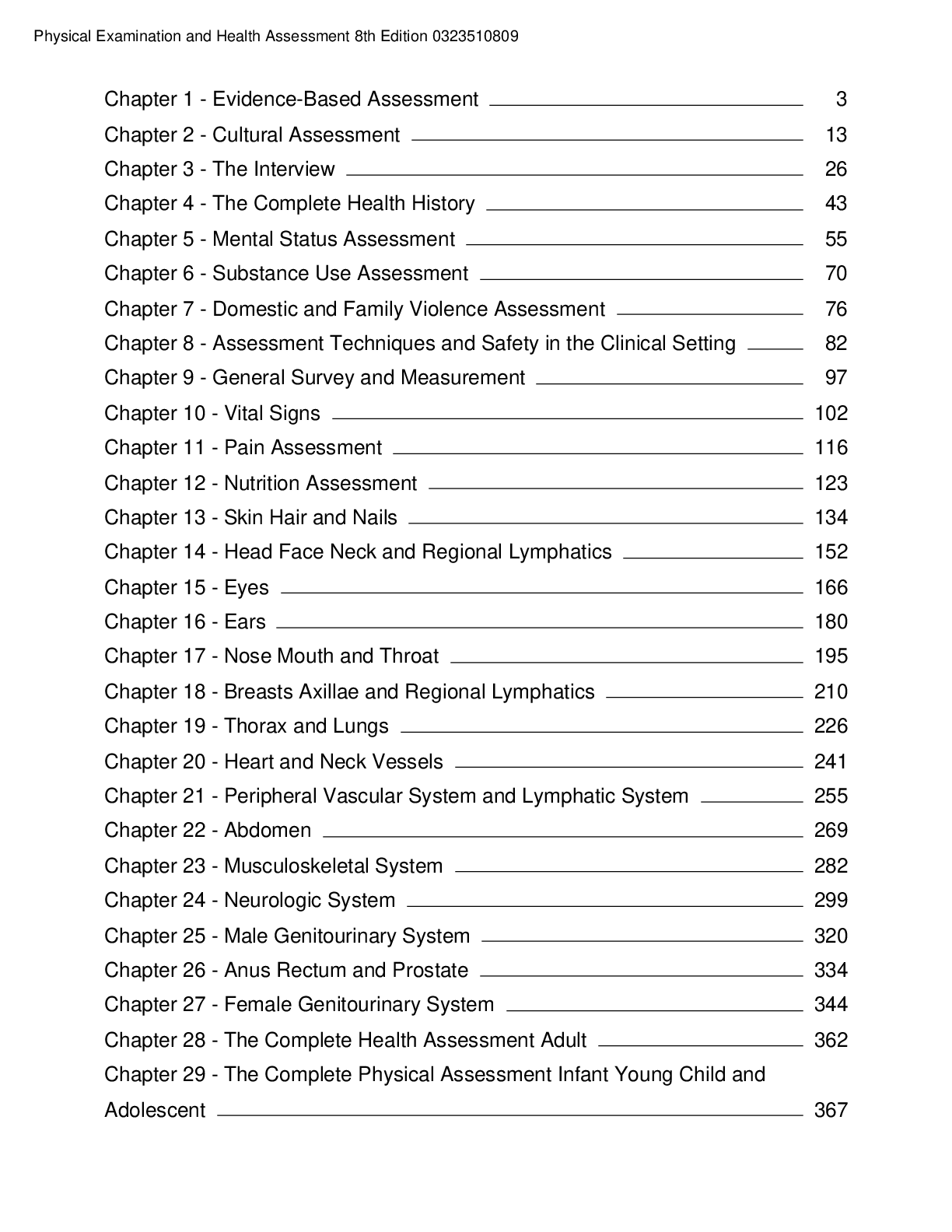
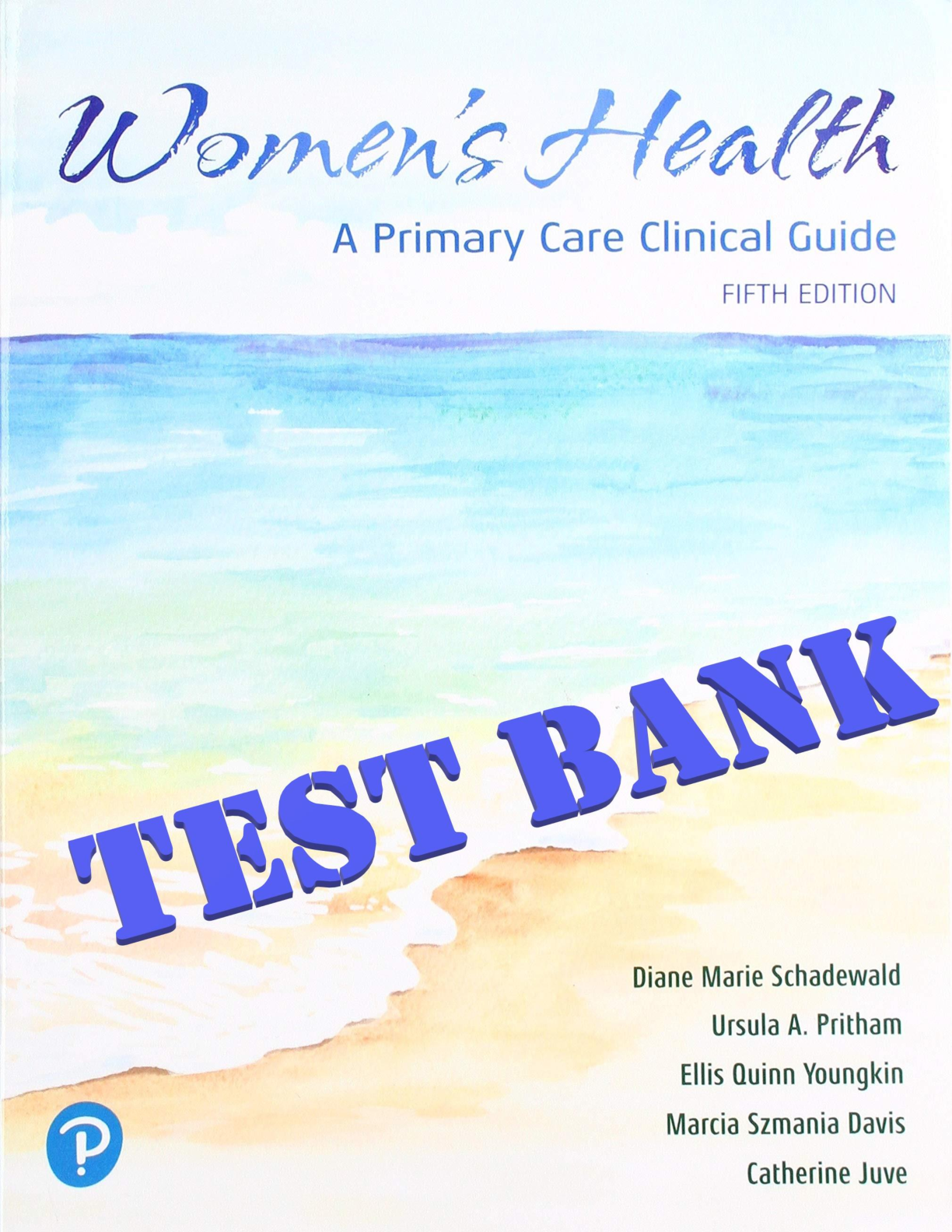
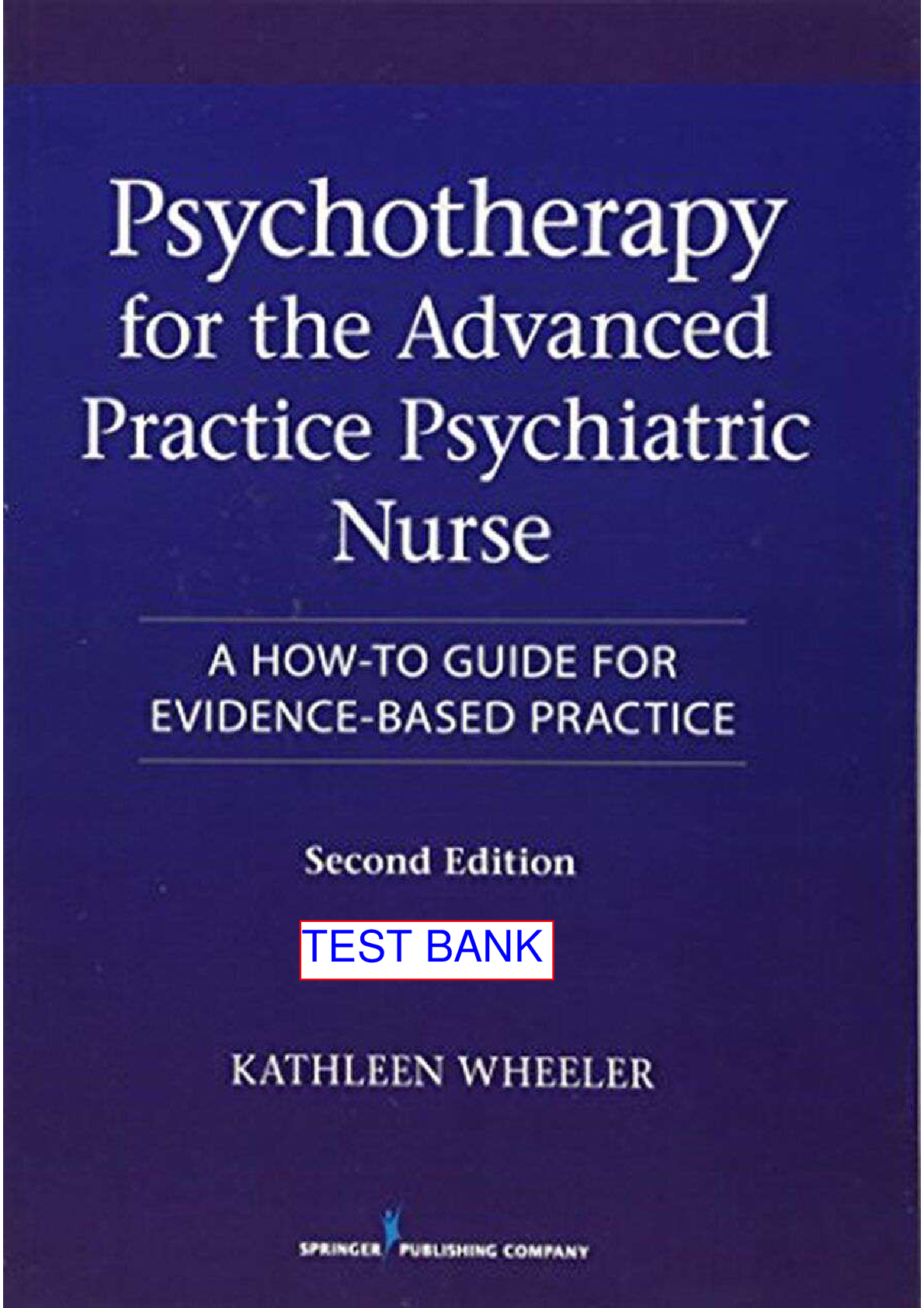


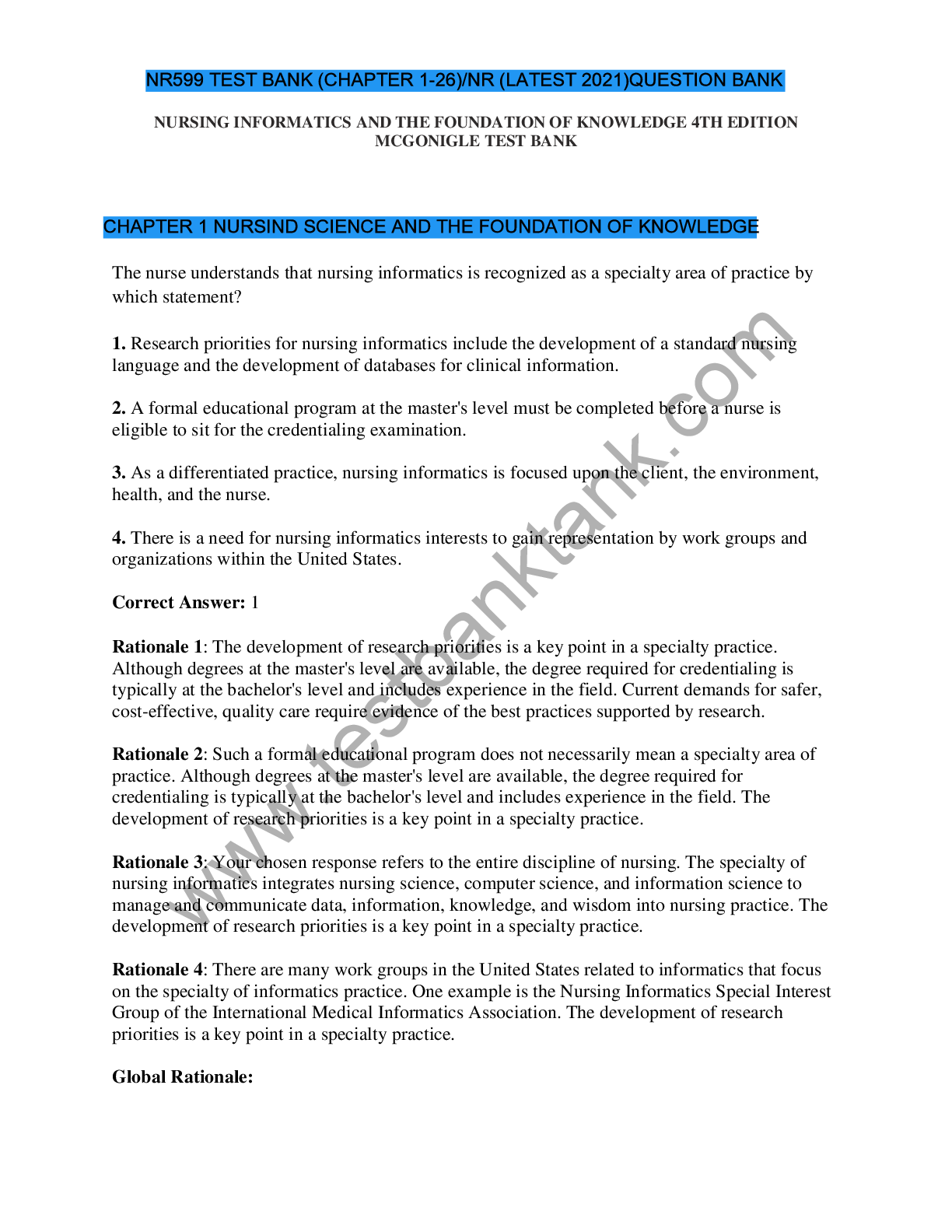
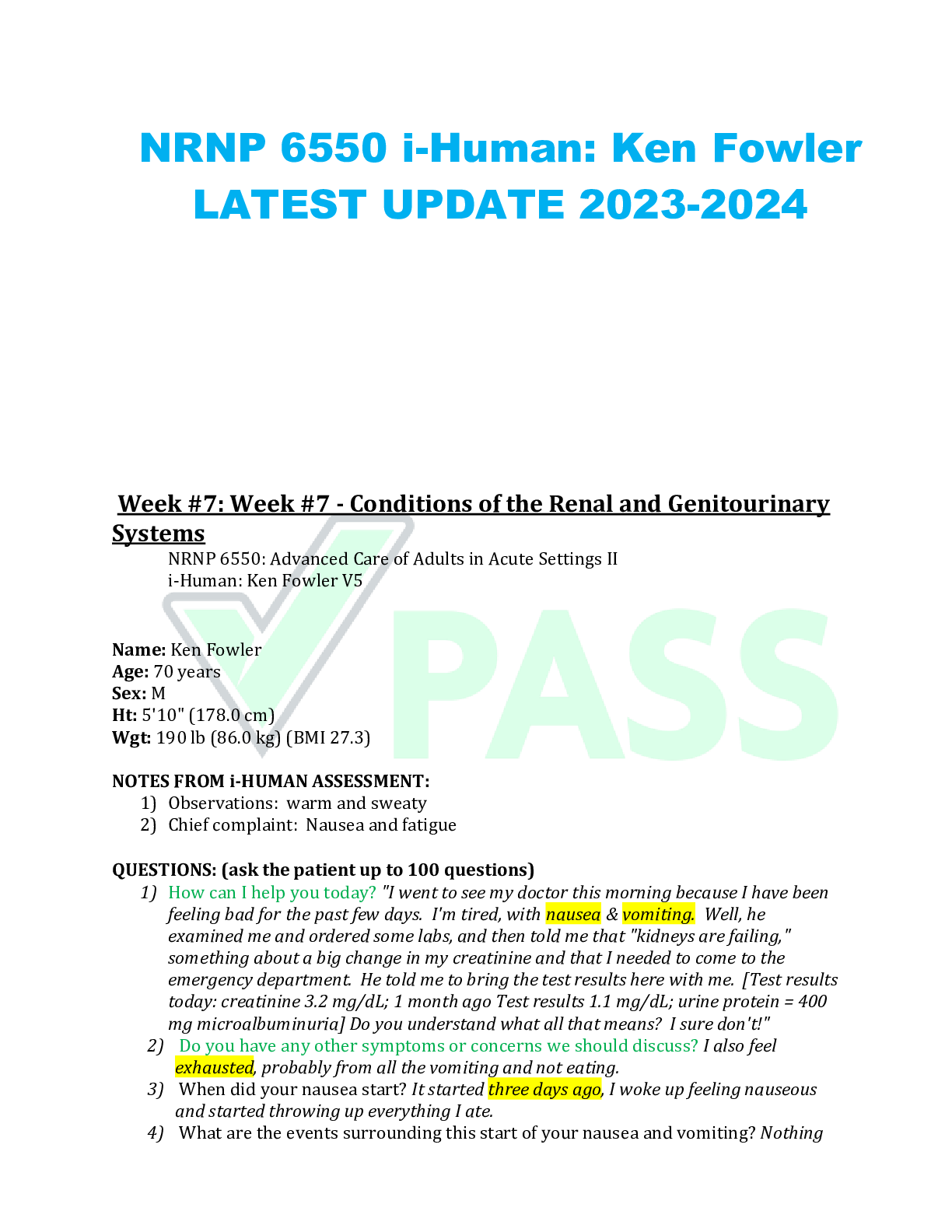
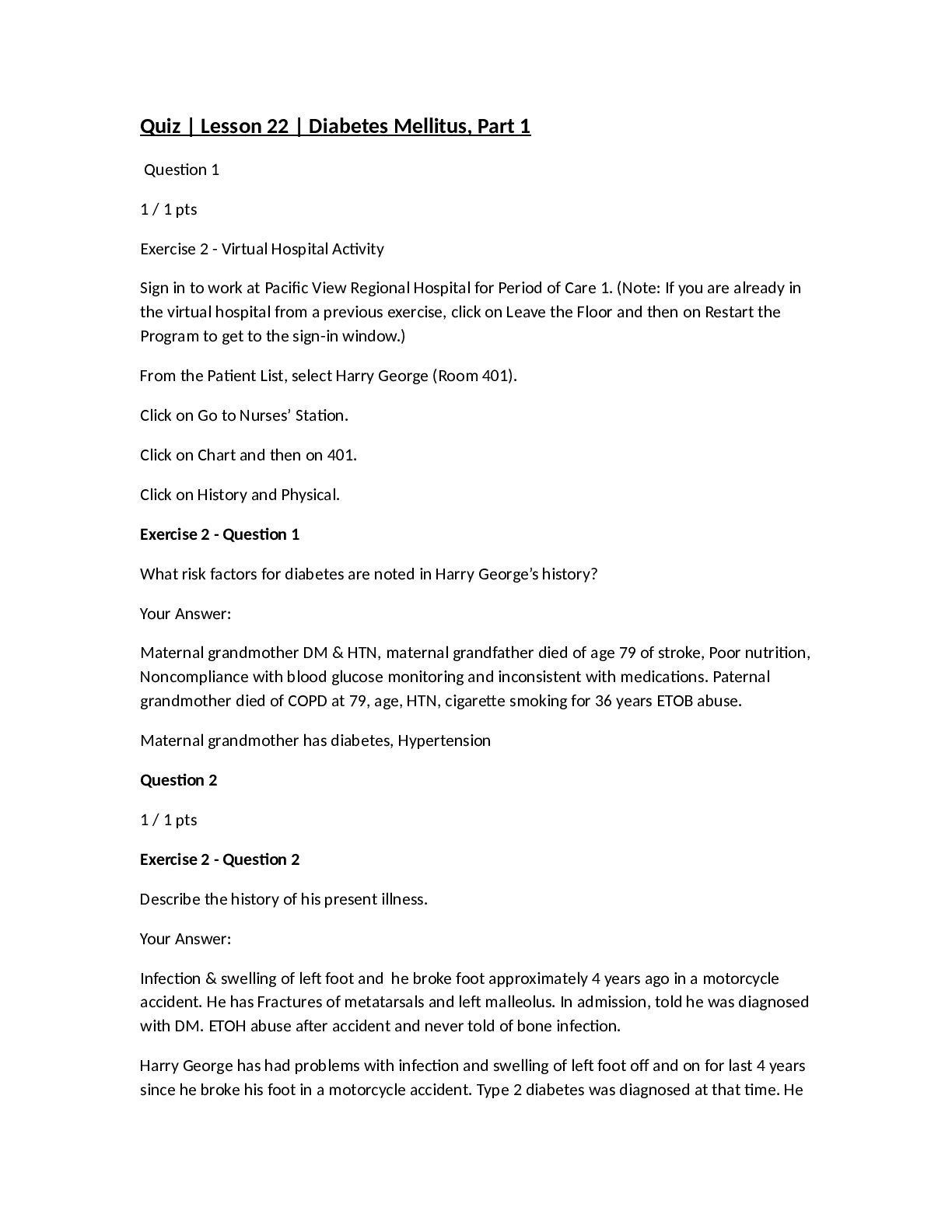
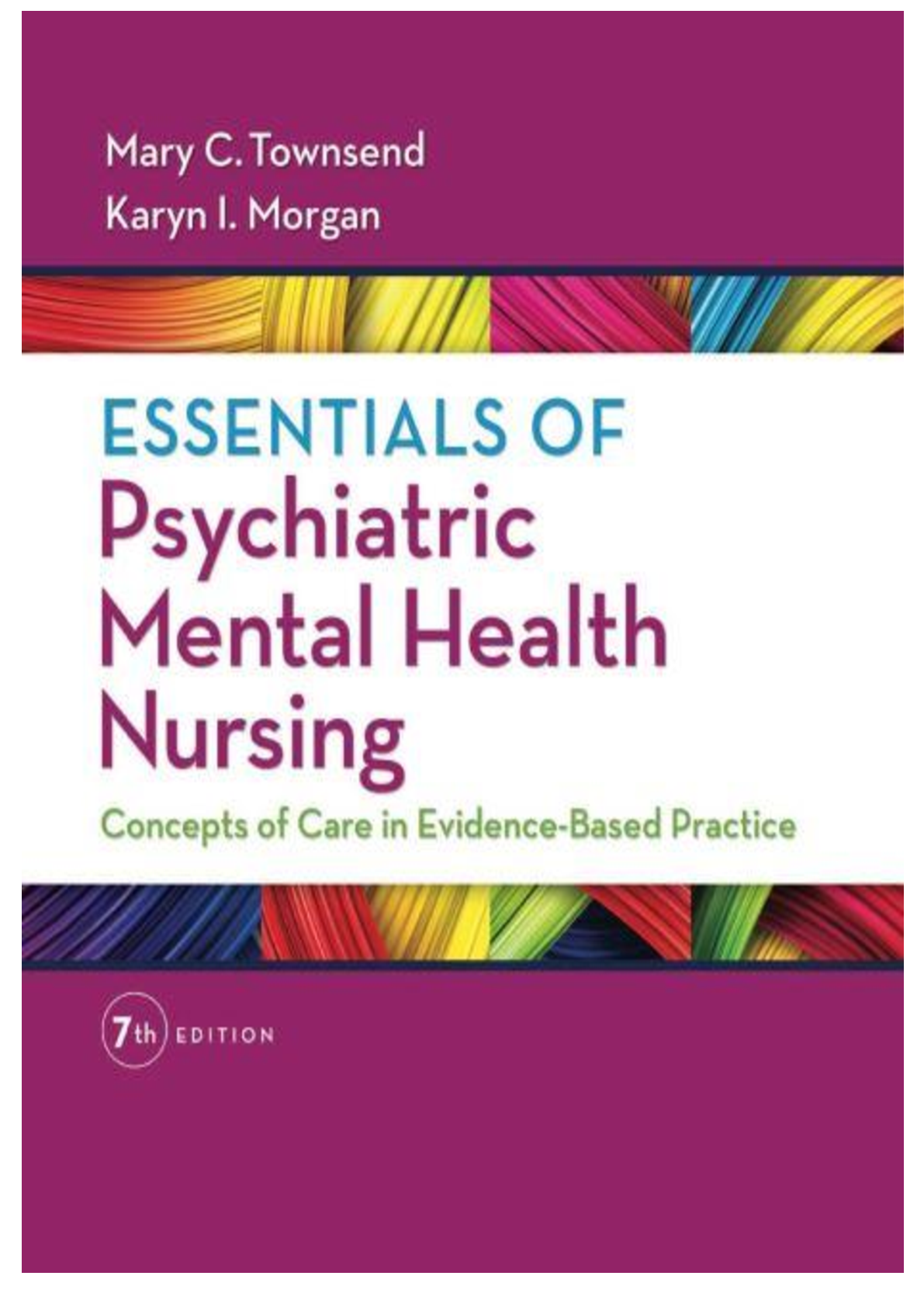
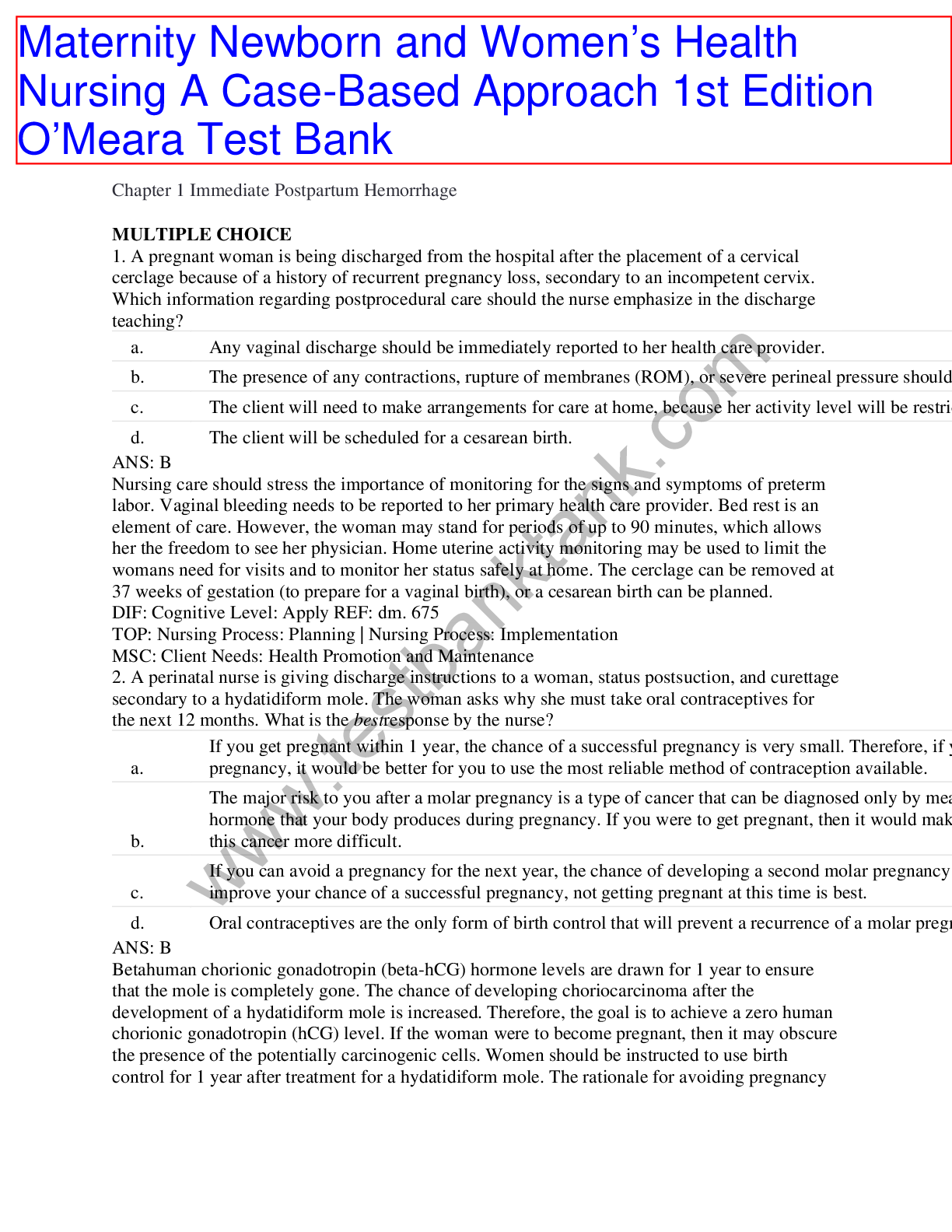

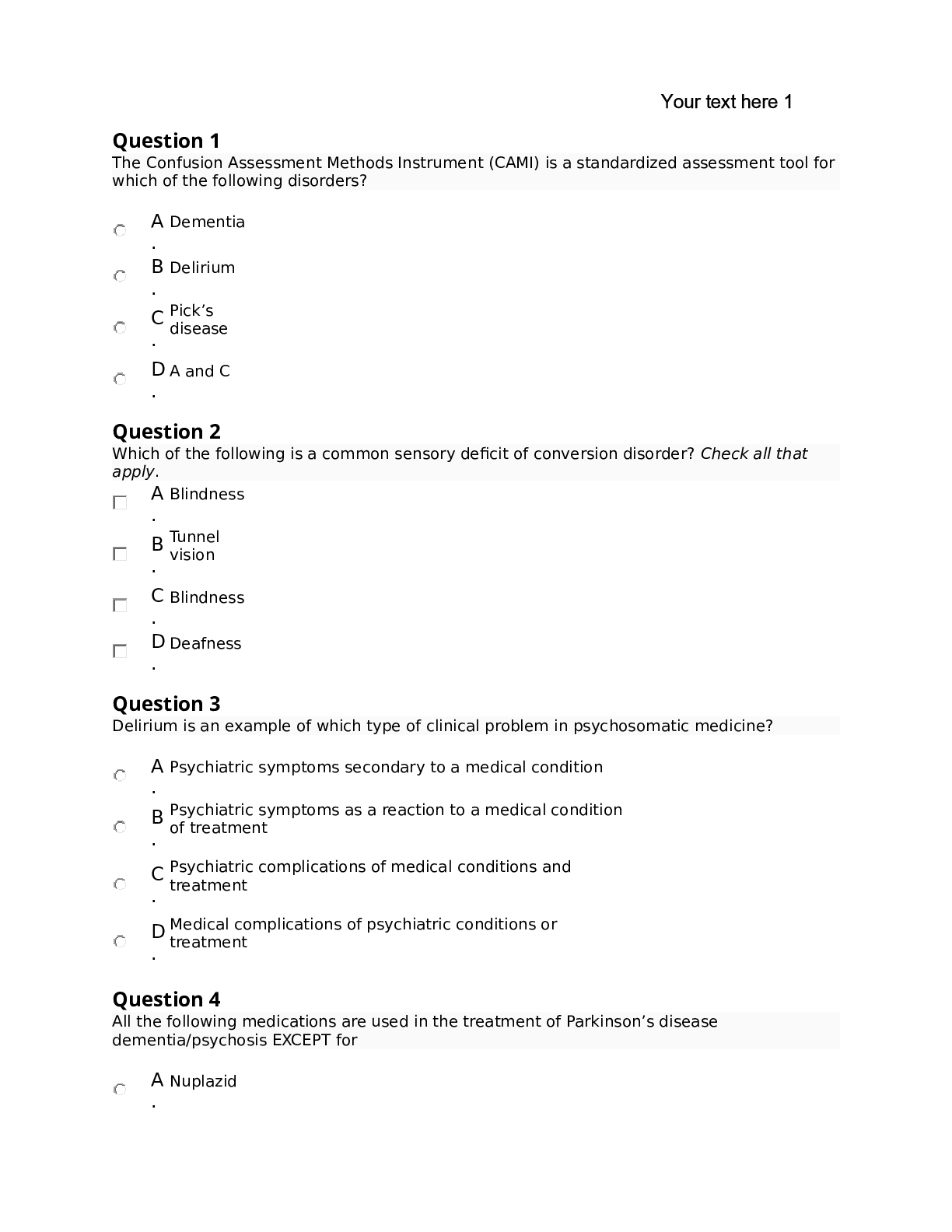
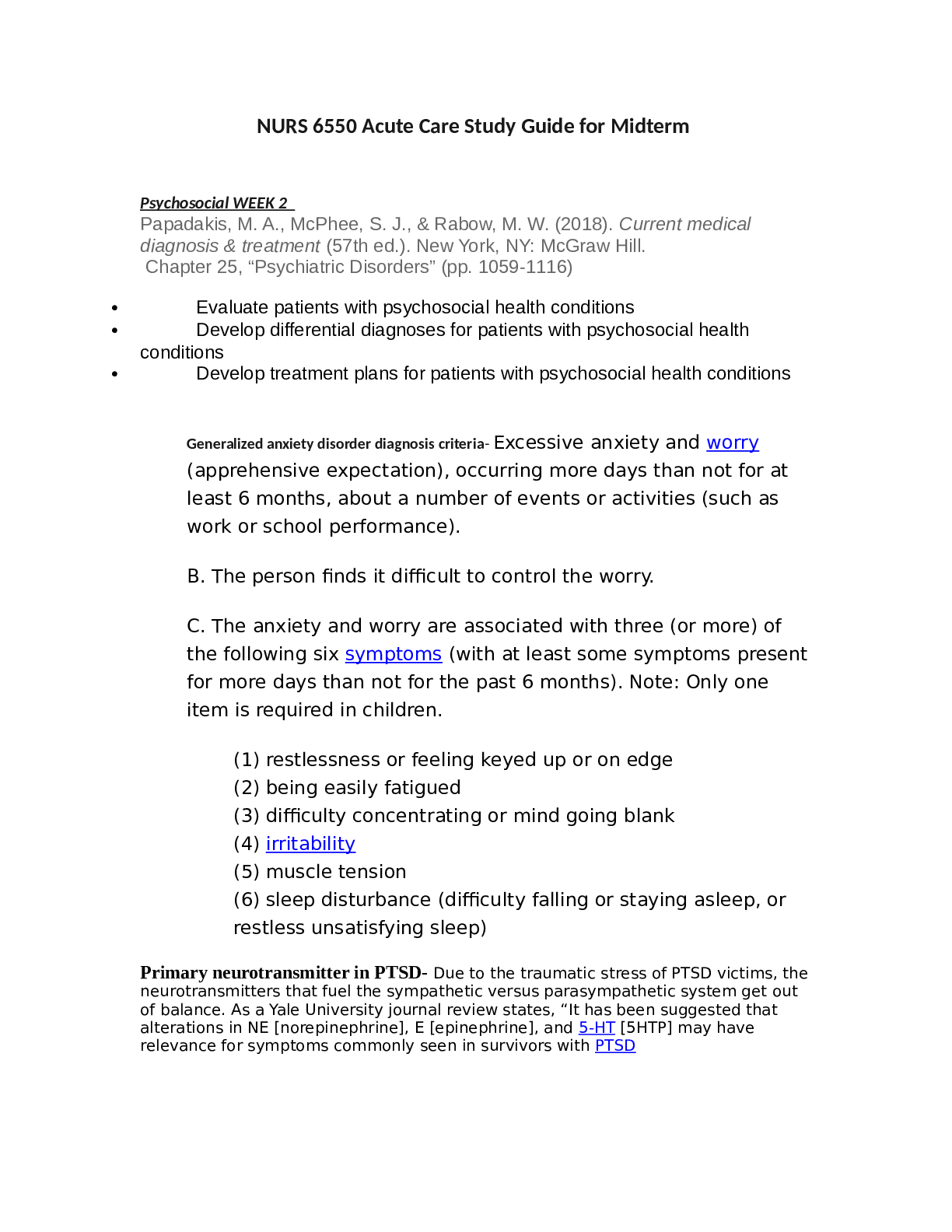
 (1).png)

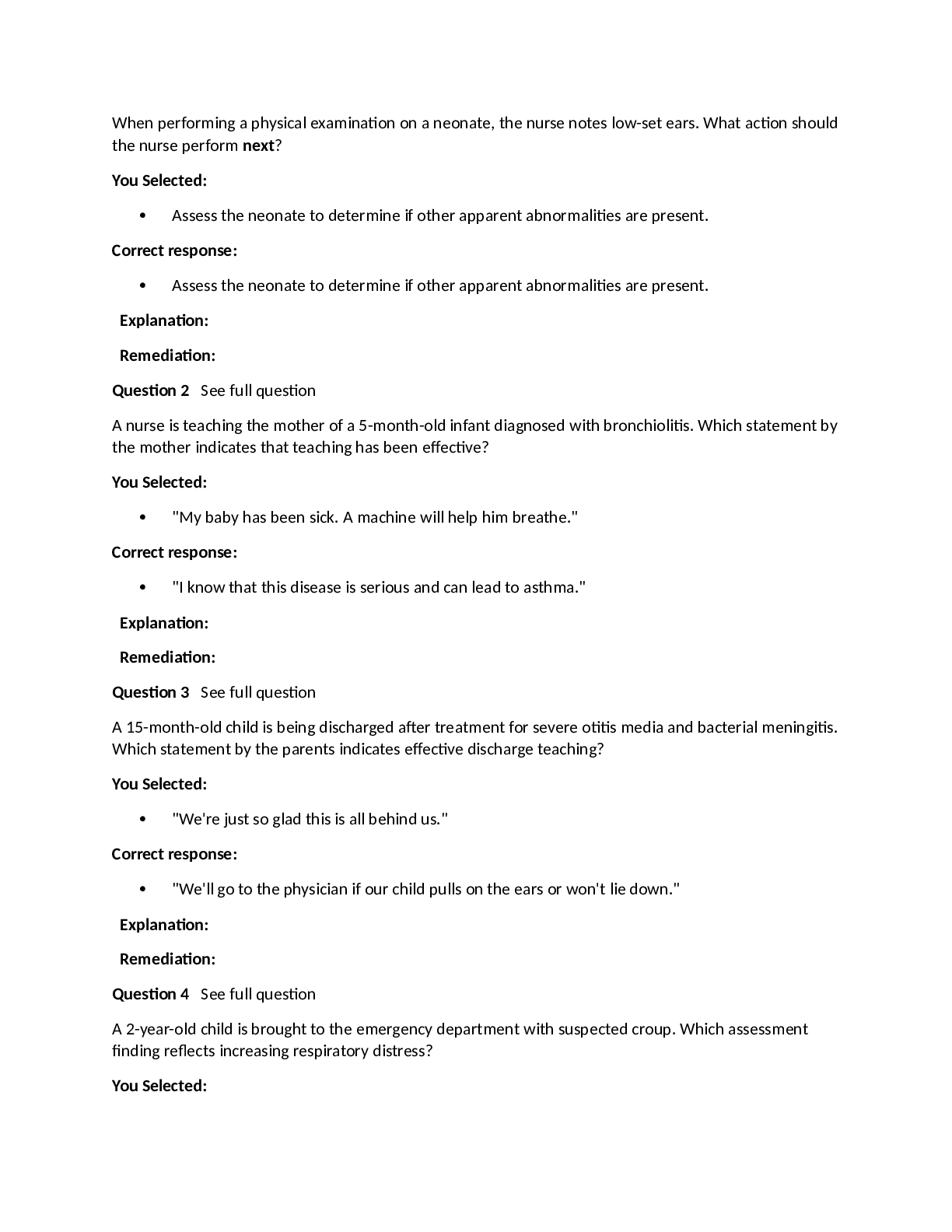
.png)
